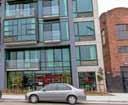

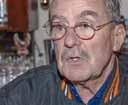
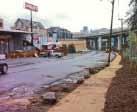

Pennsylvania Street Garden Grows
By LEEANDREA MORTON
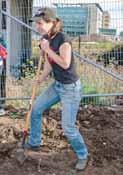
Pennsylvania Street Gardens, an initiative to improve the 100 block of Pennsylvania Street, is fnally underway after more than two years of planning. The project is designed to wholly renovate the forsaken area near Interstate-280 on the corner of Pennsylvania Avenue and 17th Street. Once completed, that strip of Pennsylvania Street will be home to 23 trees, a walking path, and a state-of-the-art storm water drainage site.
The initiative is led by Potrero Hill resident Annie Shaw, her husband, Matt Petty, and Dogpatch resident Emily Gogol. It was frst launched by Shaw, a web designer, who decided to plant a garden on a derelict section of California Department of Transportation (Caltrans) right-of-way located on 18th Street and Pennsylvania Avenue, at the I-280 off-ramp to Mariposa Street.

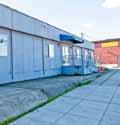


2,600+ New Housing Units Proposed for Potrero Hill
By CHRISTOPHER ROBERTS

Lead Used in Fishing Littering San Francisco Bay
By GEORGE NELSON
The use of lead in fshing tackle, sinkers and jigs has come under considerable fak from environmental groups in recent years, with many calling for a ban on the use of the metal in fshing due to its toxicity.
Lead is a perfect material to use for fshing weights. Heavy in relation to its size, a small lead weight makes minimal commotion on the water’s surface and sinks quickly, dropping the line without disturbing the fish below. It’s resistant to rust and corrosion; ideal for ocean fishing since salt water is especially erosive. Lead’s pliability and low melting point allows fshermen to easily alter the shape of each weight. And the metal’s low cost adds to its favorability; lost weights are reasonably cheap to replace.

Shaw was inspired to start the garden in 2008 after she noticed a potted, stray Princess Plant – Tibouchina urvilleana – sitting deserted on 17th Street. A few days later, looking out the window of her Pennsylvania Street home, she saw that someone had planted it by the Mariposa off-ramp. The next day, Shaw loaded her car with plants she purchased at a San Francisco Botanical Garden sale, thinking she’d never have to buy vegetation for the empty space again. “Naivety is a really good thing in situations like this, because you don’t know how daunted you should really be. Just get started, though, and people will help,” said Shaw.
After Shaw and her now husband Petty created the Pennsylvania Garden at 18th Street, a steady stream of vol-
page 9
After four years in the doldrums, California’s real estate market is back. And in a San Francisco that remained relatively buoyant even during the 2008 recession, a veritable boom in high-rise, high-density development is occurring, much of it in Potrero Hill and Dogpatch. The skyline emerging in Southside neighborhoods today could make the live-work heyday of the late-1990s dot-com boom look insignifcant.
Upwards of 2,600 new housing units have either been constructed in the last year, or will be built in Potrero Hill, Dogpatch and Showplace Square in the next fve years, if all of the plans on fle at the San Francisco Planning Department are approved. In 2008, CityData. com estimated the area’s population at just over 10,000. The massive infux of new housing could increase the Hill’s population by more than 50 percent by 2020. Combined with the 1,400 to 1,700 units that could replace the decrepit
Potrero Annex-Terrace public housing complex, upwards of 4,000 new housing units could be built in the area by 2025, adding as many as 10,000 people. And that doesn’t account for the large amounts of commercial space being developed in Pier 70 and elsewhere, which will substantially increase the neighborhoods’ population of daytime commuters.
Much of the development is taking place on vacant or underused blocks in Showplace Square, where roughly 1,300 units are planned for Daggett Place –now vacant, but formerly home to a paint factor – and at the Concourse Exhibition Center/1 Henry Adams Street site. But Dogpatch – long-praised as an “emerging neighborhood” by the New York Times and other media – could also see 1,000 new housing units.
The development boom is taking some residents by surprise. The lull in new construction while the Eastern Neighborhoods Plan was crafted lasted more than six years, followed
The U.S Environmental Protection Agency (EPA) estimates that more than 4,000 metric tons of lead – in excess of 450 million sinkers – may be dropped in American waters each year through lost fshing equipment. No one knows how much fshing-related lead is deposited in and around the San Francisco Bay.
When ingested lead can wreak havoc on the body, causing brain damage, high blood pressure, kidney disease, impotence and even death. Growing children are particularly vulnerable; lead exposure can result in permanent behavior and learning difficulties.
Birds and mammals exposed to the metal have been shown to suffer from lead poisoning in much the same way humans do. Raptors, including the California condor, have been known to suffer from lead poisoning by consuming game birds or mammals that have been shot with lead ammunition.
Lead sinkers – and shot gun pellets – that settle on the Bay bottom can be mistaken for the grit that waterfowl
4
FREE Serving the Potrero Hill, Dogpatch, Mission Bay and SOMA Neighborhoods Since 1970
Southside inside — Enhanced coverage of San Francisco’s southern communities
JANUARY 2013
NEW HOUSING page
LEAD page
7
GARDEN
INSIDE
Annual Boosters Holiday Party p.19 McKinley Square Emcampment p.12 p.27 p.8 p.20 p.S13
Sandy
Hook Beneft p.25
Left to right, developments done or in the making at Potrero Launch,
Opera Warehouse..
bY DoN
Po P u l At I o N to Ju M P B y H A l f
Corovan, Dagget Place, and the
PhotoS
NoltE
PuBlISHEr’S VIEw
Locals Pack O’Connell High to Shape Parking Plan Legacy
By Steven J. Mo S S
To understand City government’s priorities, take the following multiple choice quiz. When Ed Lee talks about what he wants to be his “legacy” as mayor, he’s referring to which of the following:
A. Fixing Muni.
B. Finding compassionate ways to cope with San Francisco’s 6,500 homeless individuals.
C. Managing development in Dogpatch and Potrero Hill, where a new city is emerging.
D. Insuring that naked people don’t roam the Castro District.
E. Building a basketball arena on the City’s central waterfront.
Now that you’ve selected your answer, consider how a mayor might view these options. Choosing a policy problem in which to deeply engage is almost as important as deciding who to marry. Given the complexities of moving anything through any legislature – especially San Francisco’s Board of Supervisors – followed by the challenges of successfully implementing a program once it’s been approved, a mayor has to be fully committed to an issue to take it on, much less try to make it their legacy.
Muni is the Liz Taylor of policy problems. Married and divorced many times, with each suitor leaving behind expensive baubles – like the Central Subway – in exchange for their failed efforts. Meanwhile, the system gets older and crankier. Who can blame a mayor’s eye from wandering to an emerging transportation starlet – City CarShare, Uber or SideCar – before getting bored and moving on to the next new thing?
The homeless issue is like a bad date. The principals themselves often resist assistance. Sometimes they smell bad. And when they are ultimately housed, many of them backslide to the streets, or are replaced by new homeless imported from Illinois, or Santa Cruz, making the whole enterprise Sisyphusian. It takes a politician with a Messiah-complex to take on this public problem; which is why former mayor Gavin Newsom made some progress with it.
It requires creativity to see a legacy opportunity in the copious development emerging in Southside San Francisco. The neighborhoods themselves have historically been home to the work boots and apron set; fun people to party with, once and a while, but a long-term relationship? Forget about it. Unlike a redevelopment project, a mayor can’t just bulldoze away the existing 19th and 20th century buildings and people and create a “jazz district,” or health care money machine. It’d take a lot of work – and resources – to orchestra the myriad building projects and associated public infrastructure needs into something cohesive, authentic, and community friendly. Other mayors – in Chicago and New York – have found this kind of challenge intriguing, but San Francisco tends towards less complicated policy goals.
Taking on clothing optional people in the Castro requires a politician to spend time with angry naked people, who often might be gesticulating furiously, with whichever body part is most easily available. Next!
Two words describe a mayor’s likely attitude towards building a waterfront stadium: trophy wife. And Golden State seems to be the perfect Warrior Girl. She’s a teenage sweetheart who eloped with someone else, in 1971 running off with that ruffian, Oakland. She claims to love San Francisco for who we are, not for our money, providing huskily whispered assurances that no fancy trinkets are needed to lure her back into our municipal arms. Sure, she may bring with her some pesky traffic congestion, and block access and views to the Bay, but think about how awesome she’ll look through a television camera mounted on a blimp, sparkling Bay water or a twinkling downtown skyline framing her in the background. And she’ll probably be willing to continue to hold a successful mayor’s hand long after he’s left office.
If you answered “A,” you’ve probably seen Steven Spielberg’s Lincoln too many times. “B” choosers are likely faith-based voters. “C” selectors are regular View readers. If you thought “D” might be a legacy issue, you probably get your information about politics from Fox News via The Daily Show. And “E”? Thanks for reading this column, Mr. Mayor.
By ANNE HOFFMAN
Special from Mission Local
Last month more than 100 people packed John O’Connell High School’s auditorium, angry about a contested plan to meter parking spaces in northeast Mission. The meeting was the San Francisco Municipal Transportation Agency’s chance to rectify the situation, to let residents know that they wouldn’t go forward with a new parking plan without community input; that this time would be different.
But the agency met with a tough crowd. As SFMTA officials asked the attendees to sit in the area of the auditorium that corresponded with their quadrant of the neighborhood, one man murmured, “They wanna divide and conquer!” It was a bit like watching an absent parent try to reconnect with children after years of missing visits and breaking trust.
“We are here to restart the process because we heard loud and clear that we didn’t get it right the frst time around. So we took a couple steps back to restart,” said SFMTA Director Ed Reiskin at the beginning of the session. Community members listened — some reluctantly — as Jeffrey Tumlin, a consultant to the project, presented newly acquired data on various aspects of parking in the northeast Mission.

letters to the Editor
Editor, I thoroughly enjoyed Sasha Lekach’s article on Plow (“Plow Grows Customer,” December) especially since I’m quoted. But I did get a chuckle out of the comment, “The area is starting to get the recognition it deserves...” I remember in Michael Bauer’s review of the 2002 opening of Chez Papa in the San Francisco Chronicle he referred to “...white hot trendy Potrero Hill.”
I sincerely hope we never lose our “quaint small neighborhood” feel with “real people.” So many other parts of the City and Country have been lost to arrogance and inconsiderate behavior.
Edward Lortz
19th Street
Tumlin discussed the Mission’s unique history, which has shaped the area’s hodgepodge of land uses. The data highlighted parking supply, regulations and occupancy at the block-to-block level. “One size certainly does not fit all,” said Tumlin.
SFMTA restarted the decisionmaking process in the northeast Mission after encountering ferce opposition from the community last year, when it tried to implement an SFpark pilot project that would install new parking meters in the area. Under the SFpark program, meter and garage prices are adjusted up or down according to demand. The goal is to reduce congestion by helping drivers quickly fnd open parking spaces. The move to manage parking comes as a 220-spot parking lot on 17th and Folsom streets is slated to be converted to a park and low-income housing development. The purpose of the meeting was to present newly acquired data and hear the community’s suggestions regarding parking management techniques in a neighborhood where parking is largely unregulated.
One man, unhappy with the response to his question about his small business, left angrily, flashing his middle fnger at Reiskin. “I’m taking my business elsewhere,” he said. Jennifer Brommer, who owns a motorcycle shop in the Mission, was close to tears. Parking in front of her shop was free for 13 years, but now she pays for her customers to park, which can cost up to $2,000 a month. “They’re destroying me with their agenda because they didn’t look closely at each block,” she said. “[That’s what] this meeting is all about, so hopefully there’s gonna be some change.”
Parking in San Francisco can be a headache, and the northeast Mission is no exception. According to SFMTA, it typically takes drivers 27 minutes to fnd a parking space in the neighborhood. The City’s transit-frst policy encourages residents and commuters to rely on BART and Muni rather than their cars, but many at the meeting, including Tumlin, said that a transitfrst policy is at odds with the desire to increase parking availability and ease. SFMTA’s goal, Tumlin said, is to make some parking available while also discouraging people from driving when they could take public transportation, walk or bike. Tumlin, who is originally from Los Angeles, said that he will probably always own a car but understands that he takes up far more street space by driving than when he


2 THE POTRERO VIEW January 2013
The Vie W is P r in T e D O n re C y C L e D ne W s P r in T W T h s O y -base D ink. Copyright 2013 by The Potrero View. All rights reserved. Any reproduction without written permission from the publishers is prohibited. ™ Masthead design by Giacomo Patri eDiTOr and PUbLisher: steven J. Moss PrODUCTiOn ManaGer: J.Durrant Ja nUa ry s Ta F F: Lynne b arnes, Jean b o glages, keith burbank, yael Chanoff, amber hawkins, sasha Lekach, Francisco Mattos, Liz Melchor, Leeandrea Morton, George nelson, Don n o lte, Christopher roberts, Mauri s chwartz, b ill s lakin. editorial and policy decisions are made by the staff. all staff positions are voluntary. Published monthly. address all correspondence to: The POTrerO VieW, 2325 Third street suite 344, san Francisco, Ca 94107 415.626.8723 • e-mail: editor@potreroview.net • advertising@potreroview.net (advertising) PARKING page 3
walks, bikes or uses public transit.
Tumlin acknowledged that Muni service in the neighborhood is “terrible.” And the not-so-quiet elephant in the room was that more meters ultimately equals more revenue for the City. According to the San Francisco Chronicle, “revenue from parking fnes and fees … generate[s] more than $187 million a year that is pumped directly into the Muni transit system.”
One community member at the meeting told SFMTA that she’d love to take public transportation, but it’s simply not an option. She said that she’d lived in New York City for several years and never needed a car, “but here it’s different, public transportation is not at that level where I can solely rely on it.”
A group called ENUF (Eastern Neighborhoods United Front) has been monitoring SFMTA’s policies with concern and anger. “Everything they say is ‘Oh, transit frst,’” ENUF member Mari Eliza said. According to Eliza, the City’s transit-frst policy began in the 1970s, when San Francisco had air-quality problems from car pollution. These days, she said, it’s a different story. “In 1973 there was really bad smog…If we’re looking at today, you’re trying to push plans that were developed 30 years ago. What’s here now is that we’re at a 20-year low for carbon emission.”
At the end of the meeting, attendees split into small groups based on their place of residence. Many residents from each subgroup spent time with SFMTA officials, giving block-by-block suggestions for managing parking to suit their streets. Others had no faith in a process that they said would ultimately be determined by SFMTA’s board of directors.
Some residents had difficulty communicating with City officials because of language problems.
Near the entrance to the meeting, an SFMTA representative asked a man to write down his email address on a mailing list, repeating the word “address,” which the man interpreted as his physical residence. Finally, a Spanishspeaker interpreted the representative’s message. “Oh, my email?” said the man. “I don’t have an email address.” He passed on the question and looked for a seat.
“Mi nombre es Victor Bonilla,” the man said later. “I live at Capp between 18th and 19th. It’s a residential area, not a commercial one. I understand that the meeting is to pass or not pass a resolution that would put meters in the neighborhood, something which would absolutely hurt the peace in the community.” Bonilla is part of a group of longtime residents who rely on cars to get to and from work, their children’s school events, doctor visits and the like.
“Look, we have three cars. I drive one, my wife drives the other and the other is my son’s. And we only have one garage…This isn’t just my problem. This is the problem of the majority of people from a certain class who don’t have big garages and need more than one car. For that reason, I am totally in disagreement with this project…If the City needs money, I can pay an additional tax, but they shouldn’t disturb our community with meters.”
Short CutS
Axis Open
Axis Café and Gallery will be sticking around the neighborhood a bit longer. Originally slated for a late December closure, according to general manager and head chef Linda Edson the shutdown has been pushed into early 2013. After a two-week holiday break, the café and gallery space at 1201 Eighth Street will re-open for breakfast, lunch and brunch on January 3. The delayed closure is apparently connected to a slower schedule than co-owners Mark and Gail Smallcombe had anticipated with the new development planned for the site. The plans call for razing the existing warehouse space to make way for two multi-story mixed-use buildings, featuring retail and offices on lower foors and living space above. Edson said the postponed changes are giving her some breathing room to work on her spin-off restaurant opening in March on Treasure Island. Meanwhile, loyal patrons have been telling Edson, “This is so great!” and are relishing the extra time and meals with their beloved eatery…Phil West, the owner of Michelin-starred restaurant Range, has formed a new corporation, Third Rail Bar, with his bar manager, Jeff Lyon, to purchase six-year-old drinks and music venue Retox in Dogpatch…La Fromagerie, a cheese and special foods shop, opened last month at the American Industrial Center (AIC)…
BAYCAT
AIC-based BAYCAT, a nonproft that educates and employs underserved youth in digital media arts, received the National Endowment for the Arts’ (NEA) prestigious Art Works grant.
The funds will help support BAYCAT’s Youth Powered Media Arts Program, which provides trainings in flmmaking, music production, animation, and graphic arts. BAYCAT is one of 832 nonproft organizations nationwide to receive a NEA Art Works grant. More than 1,500 eligible applications were submitted; this is BAYCAT’s frst NEA grant. “What an important recognition from the NEA,” said Villy Wang, BAYCAT’s founder and chief executive officer. “This grant will help us to fund some of the BAYCAT Academy initiatives and provide great programs to our kids.”…Late last year the San Francisco Board of Supervisors voted to provide the San Francisco Unifed School District $2.7 million to pay for credit recovery programs – some of which will be offered at night – to help the district’s 1,900 high school juniors and seniors who aren’t on track to graduate obtain their degrees. The Board and Mayor Ed Lee haven’t reachd an agreement on how much of the monies will ultimately be released, though roughly $1.5 million seems likely. Some of the funds will be directed to Downtown and International Studies Academy
Development
Rickshaw Bags’ iconic rickshaw was stolen outside its 20th Street headquarters late last year. Does that constitute identity theft?...Despite concerns from some that it was too remotely located, the electric vehicle charging station at Dogaptch-based Pat’s Garage is one of the City’s busiest…Progress Park will be named the Best Community Challenge Grant Project at the Fifth Annual Neighborhood Empowerment Network Awards,
the ceremony for which will be held on January 9…In response to at least two horrifc crashes in the last twelve months, the California Department of Transportation has installed new stop and directional signs at the 18th Street Overpass… Hargreaves Associates relocated to 970 Tennessee Street last month. The landscape architecture frm helped design Crissy Field and the Candlestick Point State Recreation Area, and is currently working on the Mission Rock Development Open Space with the San Francisco Giants and Bayfront Parks (P23 and P24) in Dogpatch and Mission Bay…Trumark Homes is proposing to demolish two twenty-two foot buildings at 645 Texas Street and replace them with a 40-foottall building with 101 residential units, which would also front Mississippi and 22nd streets. City code requires that at least 40 percent of the units have two or more bedrooms, or at least 30 percent feature three or more bedrooms. While Trumark’s initial proposal included a garage with 101 parking spaces, only one off-street parking space is permitted for every two bedroom greater than 1,000 square feet, plus one off-street space for every other four units, for a maximum of 39 to 59 parking spaces for the building as designed, under the site’s Mixed Use Residential zoning. The Planning Department “strongly encourages [Trumark] to minimize the number of off-street parking spaces because of the site’s proximity to public transportation, and in conformance with the General Plan and the recently enacted Eastern Neighborhoods Area Plan.”
Correction
In last month’s “Bayview Home to Poet Laureate Alejandro Murguia” Mrs. Segovia-McGahan was incorrectly identified as teaching, rather than working, at San Francisco State Univeristy.
3 THE POTRERO VIEW January 2013
PARKING from page 2
Developer Presents Vision for (Yet Another) Mission Bay Project
By KEITH BURBANK
Potrero Hill residents raised concerns about the size and shape of a proposed development at Mission Bay’s Block 40 at last month’s Potrero Boosters Neighborhood Association meeting. Block 40 is located just east of Interstate 280, along Mariposa Street. Mission Bay Development Group (MBDG) –Mission Bay’s master developer – wants to construct a 680,000 square foot office building, with space for a childcare facility, as well as possibly a café, at the site. According to MBDG planner Luke Stewart, some of the office space could be used for laboratories, though vacant lab space already exists in the area. A separate parking garage is included in the concept drawings.
At the Boosters meeting Vermont Street resident Yoram Meroz asked if the developer could construct a smaller building. According to Seth Hamalian, MBDG managing principal, the building needs to be of a certain size to secure fnancing. “The amount of square feet supports the growth in the
consume to aid in grinding food. Birds can also ingest weights attached to broken fshing line in hooked fsh. Lead oxidises extremely slowly and typically doesn’t dissolve in water, remaining in the Bay and Pacifc Ocean indefnitely.
property tax base, which then directly fnances the infrastructure, parks and affordable housing in Mission Bay,” Hamalian said.
Former Boosters president John DeCastro asked if the building could be made more “curvilinear.” According to DeCastro, buildings in San Francisco, unlike in Chicago or China, are being built as “refrigerator boxes.” Hamalian responded that MBDG tried a curvilinear concept, but the design seemed even more massive than a single box-style building. The lot’s triangular shape could explain why a curvilinear edifce looks larger than a single block building, Hamalian said.
Under the proposed design one building with four sections would be constructed, giving the appearance of four different buildings. Each section would be connected by what appears to be an enclosed walkway. The development would be built to allowable height limits, with a base height of 65 feet, a midrise height of 90 feet, and a tower height of 160 feet. The frst and
third buildings would be lower than the second and fourth sections as the edifce stretches from south to north.
Some Boosters members said that they’d prefer not to have to see the mechanical equipment on top of the building. In response, Hamalian showed a sketch that extended the building’s wall above the equipment.
“But this makes the whole building taller,” said Boosters president Tony Kelly.
“Penthouse mechanicals are allowed to go an additional 20 feet above each of these heights,” Hamalian responded.
Block 40 is one of the closest blocks in Mission Bay to Potrero Hill. It’s immediately adjacent to Interstate 280
to the west and Mariposa Street on the south. To the east is yet-to-becompleted Owens Street; to the north 16th Street. Mariposa Park will be built across from the development, at Owens and Mariposa Streets. More open space is planned for the opposite side of Owens Street, on the south side of Block 40, but that space will be only a slope to the CalTrain tracks.
In response to a question from District 10 Supervisor Malia Cohen about who would be responsible for maintaining the open space on the developed site, Hamalian said that parties leasing space in the building will pay a special assessment, the proceeds of which will be used to maintain the space.


will continue to oppose CBD’s antisportsmen agenda.”


Bay Area birds – such as loons, swans and ducks – have been found to swallow sinkers as large as 2.75 ounces.
Over the last few decades state and federal governments have engaged in signifcant efforts to reduce lead in drinking water, household paint, landflls, and gasoline, among other things.

In 2010 the Centre of Biological Diversity (CBD) – a nonproft organization dedicated to protecting endangered species - called on the U.S. EPA to “ban the manufacture, processing and distribution in commerce of lead shot, bullets and fshing sinkers.” However, U.S. EPA concluded that it doesn’t have the authority to institute a ban.
Hunters and fisherpeople, for their part, claim that there’s no evidence that lead deposits are causing widespread damage to wildlife. According to Chris Cox, the National Rife Association’s Institute for Legislative Action’s executive director, “The EPA has made it abundantly clear that lead ammunition is exempt from the Toxic Substances Control Act. Although lead fshing tackle is not exempt from TSCA, the EPA has expressly stated that there is no scientifc evidence warranting a ban. The CBD’s goal is a nationwide ban on lead ammunition and fishing tackle and it looks for any means to achieve it. That is simply unacceptable and we
“There have been over 500 studies proving that lead is highly dangerous to wildlife, especially birds who feed in and around water,” countered Jeff Miller, Conservation Advocate for CBD. “The evidence is overwhelming. The situation surrounding the ban on lead has become very political. In twenty years time lead will have almost certainly been made illegal in the fshing industry and we are going to be looking back asking ourselves ‘why didn’t we act sooner?’ It is a matter of persuading the EPA to use their infuence now before we do any more harm to the environment.”





Alternatives to lead fishing weights – including tin, bismuth, steel and tungsten-nickel alloy sinkers –are available, but tend to be more expensive. Only one of seven fshermen interviewed along the Central Waterfront was using a sinker made from a material other than lead. “I had nothing else to use as I’ve lost all my lead sinkers, that’s why I’m using this steel one,” Mike Woo, 48, said. “I haven’t had a chance to get to the tackle shop yet.”



According to Joe Podesta, 57, who has fshed the Bay for more 15 years, often from the Central Waterfront, “I lose a couple of sinkers every week but that’s the rules of the game. In all my years of fshing I haven’t seen any negative changes to the wildlife so I won’t be swapping my lead for anything else anytime soon.”




4 THE POTRERO VIEW January 2013
LEAD from Front Page
FIND US ONLINE — potreroview.net
Community Members Unhappy with Proposed Development at Concourse and One Henry Adams
By GEORGE NELSON
Archstone is planning to demolish the Concourse Exhibition Center, at 801 Brannan Street, and replace it with 435 residential units and 23,367 square feet of retail space, adjacent to another 239 apartments planned for One Henry Adams. David Baker –who has worked on a number of area developments, including Archstone Potrero, Mission Bay Block 7 and 300 Ivy – has been tasked with designing the Brannan Street building. The One Henry Adams site, covering 1.65 acres, would include more than 13,000 square feet of commercial space, and is being designed by Jon Worden.
The ‘formulaic nature’ of Archstone’s planned developments at 801 Brannan Street and One Henry Adams irks some Potrero Hill residents. “They use the same architect again and again and the vocabulary is no different,” said Dick Millet, Potrero Boosters Neighbourhood Association vice president. “The Concourse will also be greatly missed.”
Some community members feel that they’ve been blocked out of the development’s planning process, with little compromise being made with regards to the style of the proposed projects. “The developers seem to deal with the public just enough to get past the public,” claimed Potrero Hill resi-
dent David Glober.
According to Jim Meko, founder and chair of the SoMa Leadership Council, “The project to my knowledge is pretty much unchanged from the original plans submitted in 2010. They have a formula for this kind of thing and they all start to look very much alike. Trying to get David Baker to shift his thinking is like moving a mountain.”
“I think it’s best you put me down as “no comment”,” said Bill Poland, chair of Bay West Group, which owns the Concourse, when asked if he had the best interests of Potrero Hill residents in mind when designing the new Brannan Street building.
The proposed retail space on the ground foor of both developments has also come under fak. “It’s just a ton of residential with a little bit of rubbish on the ground foor which is supposed to make the housing worthwhile,” said a Harriet Street resident.
“We wanted a seat at the table and we fought for it. The community insisted on a mix of uses, as opposed to mixed-use, this is a huge difference. One building might be commercial, one residential, another might be a mixture of the two,” said Meko. “The Eastern neighbourhood plans are written at the planning department, not in the community. The planners are living in a bubble.”


Plans to develop the sites may have be temporarily delayed as a result of the imminent acquisition of Archstone by Equity Residential and Avalonbay Communities, Incorporated. According to David Baker associate Kevin Markarian, “The schedule of construc-
tion have changed given the situation. We should know more as the deal unfolds. It appears to have been put on hold for now, but we’re still going through all the steps right now with our entitlements.”

5 THE POTRERO VIEW January 2013
The showplace square neighborhood. PhotoS bY DoN NoltE
480 Potrero Avenue Could Become Large Box
By G EORGE N ELSON
The San Francisco Planning Department is reviewing a proposal to develop a large pit currently used as a makeshift skateboard park at 480 Potrero Avenue into a 58-foot-tall, six-story building, with 84 apartments and more than 13,000 square feet of retail space. Developers want to build 26 one-bedroom and 58 two-bedroom apartments, with 38 parking spaces in a one-level basement garage. The vacant lot, on the northwest corner of Potrero Avenue and Mariposa Street, was once a four-story live/work concrete structure, which was demolished in 2005.
The new building would contain 9,354 square feet of common open space consisting of a courtyard and roof deck. An automobile body repair garage and the Verdi Club, both two-story buildings, neighbour the site.
Architect Reza Khoshnevisan, with project sponsors Sia Consulting, designed the proposed edifce, which has come under fre from community members. “The size of the building concerns us and we feel it will be out of place in our neighbourhood. It looks from the design to be a bit of an eyesore,” said Denny Palmer, manager of the Verdi Club. “We are also concerned that the new tenants will move in and start complaining about our events. We have live music and various other things going on most nights.
I’ve heard about this happening in other locations, particularly when lofts started going up in SoMa near the clubs.”
According to a Hampshire Street resident, “You only have to take a look around the immediate area to realise that a six-story building will stick out like a sore thumb. The planners are insane.”
The project is located in the eastern portion of the City’s Mission Area Plan – part of Eastern Neighbourhoods Planning – which is designed to “preserve the diversity and vitality of the Mission” while increasing the amount of affordable housing. Objective 1.2 of the Mission Area Plan states, “It is important that new housing be developed in appropriate areas and that it be compatible with its surroundings.” However, many development proposals that fall under the Eastern Neighbourhoods Plan have been met with discontent from Potrero Hill residents in recent months, with potential projects at both the Concourse and One Henry Adams proving unpopular.
Khoshneivsan was unavailable for comment, but according to City planner Ben Fu, “There are review and approval processes for other City agencies before the project can begin construction. Therefore, it is impossible to estimate the construction timeline at this point.” Initial plans indicate that it would take roughly a year to construct the building.






TAKE OUT A CLASSIFIED AD IN THE View
email: production@potreroview.net
6 THE POTRERO VIEW January 2013
by the inability of developers to secure financing during the housing crisis, created almost a decade-long respite from signifcant land use changes. But building in Potrero Hill has always been part of the City’s master plan for new housing, and was subject to active discussion while the Eastern Neighborhoods Plan was being created.
Part of the Plan
Potrero Hill has seen all this before, in a way. Following a neighborhood uprising over the live-work lofts built during the late-1990s under thenMayor Willie Brown, development was curtailed while a plan could be hatched with community input. After countless meetings and workshops, marathon City Hall hearings and wrangling over zoning laws that stretched nearly seven years, the Eastern Neighborhoods Plan emerged.
The plan, pushed into law in 2010, just as the last of the Board of Supervisors’ “Class of 2000” – including District 10 Supervisor Sophie Maxwell and the influential development-minded Board president Aaron Peskin – were termed out, allowed housing to be built in areas formerly zoned PDR, a lightindustrial designation for “production, distribution, and repair.” Plots previously restricted to PDR are now zoned “urban mixed use,” which allows a mix of PDR, retail, and housing to be built, as well as just housing. The plan also relaxed height restrictions. Before it was adopted, for example, the sixstory buildings proposed for 2121 Third Street wouldn’t have been allowed.
The development process during the period when the plan was being hashed-out slowed to the consistency of a bottle of blocked ketchup. Condominium and rental housing projects had to go through a “conditional use” authorization process, under which neighborhoods had to be canvassed to build support, without which even the most thoughtful proposals could be felled by vocal opposition from residents. Projects proposed or permitted before the Eastern Neighborhoods Plan process was completed were put into a “pipeline.” By late 2012, 143 construction projects of varying sizes were in the pipeline. Once the plan was in place those projects were allowed to proceed, contributing to the current “boom” of active building permits and new development projects.
The idea was always to allow Potrero Hill’s population to grow “over time,” according to Peskin, who noted that the very plan that allowed the developments to which some residents now object was created with their participation.
“Potrero Hill was at the table,” the ex-supervisor said in a brief e-mail interview. But so were developers, who sometimes outnumbered residents at the many meetings held as part of the process. “And now [community members] see the development that’s going on because of the rezoning,” said Janet Carpinelli, Dogpatch Neighborhood Association president. “And they’re up in arms.”
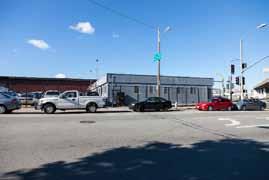


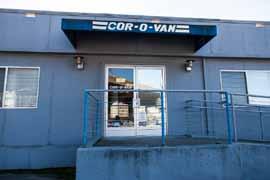


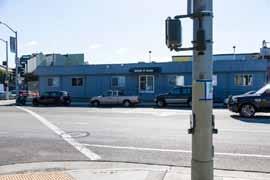
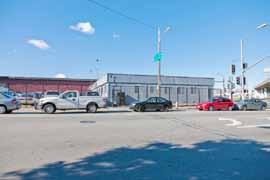
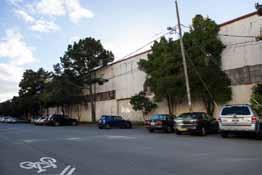
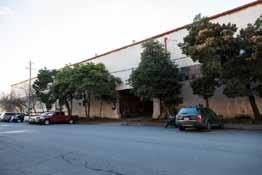


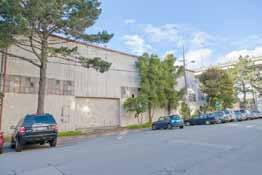
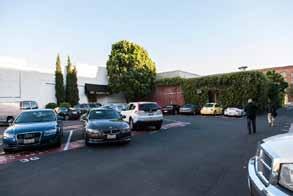
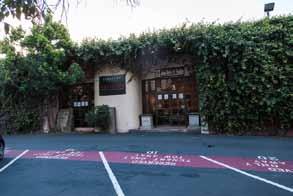



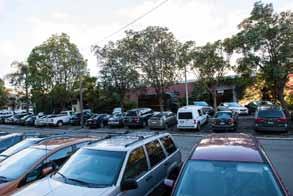


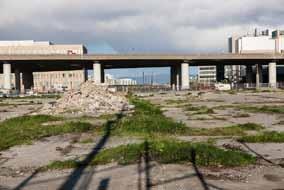

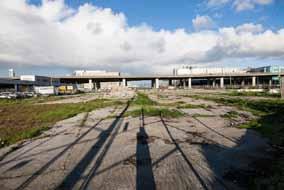





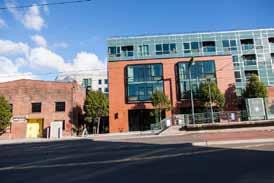
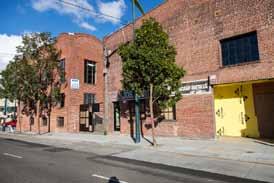
Housing is the New Industry
The days when Potrero Hill was a shipbuilding and manufacturing mecca are gone forever. Pier 70’s cranes are






silent. Memories of the neighborhood’s identity as blue-collar community are fading, barely visible in the barroom at Bloom’s Saloon or in the corrugated tin siding at the old Corovan site on 16th Street. That’s where Walden Development and Kaiser Permanente propose to build a medical office and outpatient center mixed with 189 housing units. Other working-class staples are also slated to become homes; 350 units of housing are proposed for the San Francisco Opera’s warehouse at 800 Indiana.
“People are going to be beside themselves” when they see the new neighborhood, said architect Kepa Askenasy, who is active with Save The Hill, a neighborhood group opposed to the Kaiser/Walden medical building and apartment complex on 16th Street.
AAR on P ESKI n
“There are neighborhoods that are welcome to this kind of development. This is not one of them.”
Potrero Hill remains a place where people work: the neighborhood supports 30,000 jobs, according to a 2008 City estimate. Many warehouses and other light-industrial buildings built last century are still operating as they were intended; delivery trucks ply the streets. Beer and wine are made in Dogpatch, Potrero Hill, and adjacent Bayview. But the next wave of land use – to high-density housing – may represent a more fundamental sea change than the shift from steel mills and paint factories to lighter industry that occurred almost a half-century ago, one that may surprise residents lulled to sleep by the construction pause.
Views like Askenasy’s are dismissed as NIMBYism by the development-minded, as refected in a recent San Francisco Business Times editorial which excoriated opponents of the Kaiser development, and blamed them for blocking San Francisco General Hospital’s plans to build a helipad. But whether one is a skyscraper junkie or a back-to-the-land extremist for whom only a cabin will do, there’s no denying that population and density increases in Southside San Francisco will trigger demands for new infrastructure, including transportation services, sewer and water systems, schools and open spaces, in an area many claim is already defcit in all of these things.
This is the first in a three-part series on development.
7 THE POTRERO VIEW January 2013 Boom Times are Here Again In addition to South of Market skyscrapers, condominium towers on Treasure Island, and new housing at the former Hunters Point Shipyard, developers are proposing to build or have begun securing permits to construct multiple high-density residential buildings in Potrero Hill, Dogpatch and Showplace Square, including the following. D E VELOPER / A D DRESS PROPOSED HOUSING UNITS Kaiser Permanente/ Walden Development, 16th Street 189 Archstone, Opera Warehouse/800 Indiana Street 350 Archstone, Dagget Place/1000 16th Street 450 Archstone, 1 Henry Adams/801 Brannan 819 Potrero Launch (Open), 2235 Third Street 196 Mission Piers Development LLC, 2121 Third Street 104 Avant, 1201 Tennessee Street/740 Illinois 300 2298 Third Street 196 1301 Indiana 81 1004 Mississippi 28 Annex-terrace 1,400-1,700 616 20th Street 16 1717 17th Street 20 1006 16th Street 393 tot A l (excluding Annex-terrace) 2,692 NEW HOUSING from Front Page
A R CHST on E oPERA WA REHoUSE / 800 In DIA nA ST REET A R CHST on E , DAGGET P L ACE / 1000 16T H ST REET A R CHST on E , on E H E n RY A DAMS / 701 B R A n nA n K A ISER P E RMA n E n T E / WA LDE n DE VEL oP ME n T 16T H ST REET MiSSioN PiERS DEvEloPMENt llC , 2121 thiRD StREEt Po T RER o L AU nC H (oPE n ), 2235 T H IRD ST REET
“Potrero Hill was at the table.”

PREFund opens Potrero Kids in Dogpatch
By K E ITH B U RBANK
Potrero Kids at Daniel Webster Elementary (PKDW), a pre-school originally launched as part of an effort to increase enrollment at Daniel Webster Elementary School, has added a second facility. The new school, Potrero Kids at Third Street, opened late last year in the recently constructed Potrero Launch. Seventy children are enrolled in the school – its capacity – with 59 typically present on any given day. Asked if a third location is planned,
Potrero Residents Education Fund’s (PREFund) administrative director Stacey Bartlett said, “I wouldn’t say yes, and I wouldn’t say no. It’s a community thing. If there was a need in the community...”
In 2005, the San Francisco Unifed School District Board of Education wanted to close or relocate three of Potrero Hill’s five schools – Daniel Webster, Enola Maxwell Middle, and International Studies Academy – leaving the community with one elementary school and no middle






school. A six-week effort by parents and concerned residents resulted in the creation of PREFund, a group of volunteers dedicated to championing “public education on the Potrero Hill… through grant making and strategic and programmatic support.” PREFund convinced the board to keep Webster open, contingent upon several factors, one of which was increasing the school’s enrollment.
PREFund formed PKDW as a feeder program for the elementary school. After establishing the preschool, “the enrollment went up,” said Daniel Webster principal, Moraima Machado, “and we were able to serve the families that live close to [Webster].” Today, nonproft PREFund is funded through tuition fees.
PK Third Street offers a Spanish bilingual curriculum, geared towards feeding into Webster’s Spanish immersion program, which has a goal of graduating students who are fully bilingual. “We’ve been pretty successful at that,” Bartlett said. In addition to the language program, PK Third Street operates two enrichment programs: music and story-telling. Story-telling is provided by a librarian from the Potrero Branch of the San Francisco Public Library. According to Bartlett, more programs will be offered in the future.
PK Third Street follows each child’s interest to guide their learning. For example, one day the kids heard a ship’s horn blow, piquing their interest in the sea and port. Later, the teachers took them on a feld trip to
learn about the San Francisco Bay and boats. “It’s a totally different mindset,” said Mimi Kawakami, PK Third Street’s program director, of the research-supported method. The approach was frst described by William Heard Kilpatrick in a 1918 essay “The Project Method,” according to a paper by Michael Knoll of the University of Bayreuth in Germany. According to Kawakami, the learning method requires teachers to spend signifcant amounts of time observing their students, and less time teaching from a prepared plan.
Preschool for All (PFA) – a Citysponsored, free, high-quality, partday preschool program available to all four-year-olds in San Francisco – held workshops for PK Third Street teachers to prepare them to use the method, Kawakami said, and a PFA consultant conducted private consultations with the teachers.
With regard to enrolling in the new school, Bartlett said, “it’s a tough time of year to quantify the waiting list. Most people want to stay put wherever they are until the beginning of the new school year.” Families with collectively roughly 100 kids have expressed interest in starting at PK Third Street in the 2013 and 2014 school years. Parents can apply to the preschool when their child is six months old; however, they have to be two years old by September 1 to enroll. To attend PKDW, a child must be at least four years old by September 1.






8 January 2013
Potrero kids at Third street. PhotoS bY DoN NoltE
GARDEN from Front Page and the Eastern Neighborhoods Public Beneft Fund. Along with Caltran’s support, these monies helped nurture the Pennsylvania Garden at 18th Street, and funded the construction of the latest garden at 17th Street.
unteers have followed, including Gogol, who introduced herself to Shaw less than a year after her initial act of guerilla gardening. The small team hatched a plan to revitalize the neglected corner of 17th Street and Pennsylvania Street.
Gogol, a research scientist, served as grant writer, and helped secure funding from the Community Challenge Grant Program, San Francisco Public Utilities Commission, Healthy People 2020 Community Innovations Project,
“The Pennsylvania Garden project [at 18th Street] happened by the skin of our teeth,” Gogol admitted. “We just put it in frst and asked for help later. The project we’re working on now [at 17th Street] is huge.”
The team leading the 17th Street project hosted three reconstruction


workdays late last year that included neighborhood volunteers and staff from Friends of the Urban Forest (FUF), a nonproft San Francisco tree planting organization. FUF plants roughly 1,000 trees annually. It offers its services once about 20 San Franciscans commit to planting at least thirty trees in a defned area. FUF schedules the planting event, helps coordinate activities, recommends tree species, and undertakes necessary preparations, such as sidewalk concrete removal and auguring. Auguring – pre-digging – loosens the soil so that holes can easily be dug. It’s necessary in places like Potrero Hill, where the soil is tightly packed.
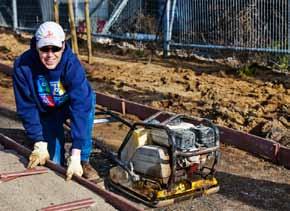

FUF charges $105 per tree, including prework and two maintenance visits two and 18 months after the trees are planted.
Last year’s Pennsylvania Street workdays marked Heidi Lakics’, FUF planting manager,
72nd tree-planting, reflecting 2,140 trees. “After two years of planning, it’s so fantastic to fnally see the trees in the ground,” said Lakics.
Prior to reconstruction and tree planting, the 100 block of Pennsylvania Avenue was subject to daily graffiti tagging, dumping, prostitution, arson, and homeless camps. A retention wall, installed last fall, decreased the dropoff to the area beneath I-280 from eight to six feet, making illegal activity more difficult to conceal. Since then the number of illegal activities has declined. “Now people feel like someone cares, so it’s no longer a great place for crime,” said Gogol.
The 100 block of Pennsylvania Avenue will ultimately feature a host of low-maintenance trees, such as European Olive, Purple Peppermint, and Acacia. A decomposed granite walking-path has been installed, as well as bio-retention cells that absorb rainwater and flter out pollutants instead of redirecting raw storm water to sewers and pumping it into the bay. The project will be fully completed by next winter, with an opening celebration to be held next summer.
“The community needs to know that they too can do this. It just requires a little vision and stubbornness,” said Shaw.
“We get to have our own garden in San Francisco. What a privilege” Gogol affirmed.
See page 27 for pictures of the fnished garden.
9 THE POTRERO VIEW January 2013
Volunteers pitch-in at 17th and Pennsylvania streets. PhotoS bY DoN NoltE
New Wireless Antennas to be Installed in Dogpatch
By y A EL CHANOFF
Despite initial opposition from some Dogpatch residents, late last year AT&T received the go-ahead from the San Francisco Planning Department to modify an array of wireless antennas located on a Third and Mariposa streets building. The phone company currently has two antennas on the roof of the Copy World building, at 2001 Third Street. The Planning permit allows these to be replaced with up to nine panel antennas and associated equipment. The change is intended, in part, to improve wireless connections in the area.
Prior to approval the Planning Department received 20 emails from concerned residents, along with a petition containing 42 signatures, opposing the project. David Grossblatt, who lives across the street from Copy World, launched the petition drive. “The idea of nine antennas sounded very ominous,” said Grossblatt. He and other neighbors worried about health
and fnancial risks, with concerns that “[antennas] can reduce the value of property if they’re visible,” Grossblatt said. “It was very grassroots,” Grossblatt said about the campaign against the antennae expansion
Grossblatt contacted the Planning Department’s Michelle Stahlhut, the project’s point person, who put him in touch with AT&T. A meeting of concerned residents was held on November 13, two days before the permit application was set to be heard before the Planning Commission. According to Grossblatt, the gathering was a success, with AT&T real estate specialists and scientists on hand to answer questions. “They definitely had a perspective,” Grossblatt said. “But I thought they were very responsive. They alleviated a lot of our concerns.”
concerns about property values. It also became clear how common these types of projects are. As the demand for data transmission increases, Stahlhut said, so too will installation of antennas. Modifying the arrays is a “continuous process for all of the major carriers,” she said. This is a “pretty common type of permit to come before the Planning Commission.”

The antennas will improve wireless internet access for AT&T customers in the area, improving access from computers, cell phones and other devices. AT&T customers who use smart phones will experience fewer dropped calls and faster downloads and text messages, according to AT&T spokesperson Stephanie Rosa. AT&T customers who use cell phones without wireless capabilities won’t see improved coverage.
emissions by a neutral party, with fndings submitted to the Department of Public Health. The engineering frm Hammet and Edison examined the Third and Mariposa streets proposal, and projected that it would result in a radio frequency of 0.52 milliwatts per square centimeter, or 8.8 percent of the Federal Communications Commission’s public exposure limit.
“AT&T customers are using their smart phones and wireless devices in a manner that has caused a 20,000 percent increase in demand over the past fve years, and we expect it to continue to grow,” Rosa said. “So we’re working to upgrade the network in this area and throughout San Francisco.” The company still needs to obtain electrical and building permits, which could take several months. After that, construction can begin.
For example, the group learned that a parapet style roof would hide the antennas from view, alleviating some
The City requires wireless communication technology projects to be evaluated for expected radio frequency
“All things being equal we’d rather they not be up, but that’s not the world we live in,” Grossblatt said. “We live in a world where everyone, myself included, uses wireless technology.”
Sophia, Happy six years!
We’re so proud of our young lady.
Love, Mom and Dad


Lena Fischer celebrates her frst Birthday and her First Cupcake! Happy One Year! We love you. Mom (Sarah) & Dad (Aaron) December 1, 2012
This is what Daisy looks like when she wants a belly rub. She will be two years old in January. “Daisy,” drawing by Henry, turning nine in January.

Sean, mucha felicidad para su quinto año fantástico! Happy birthday kiddos, we love you mucho!
Mommy y Papi!


Claire, have a great lucky seventh year, Mom and Dad
happy ninth birthday, Imogen!


10 THE POTRERO VIEW January 2013
The View is delighted to publish local kids’ birthdays, accomplishments, and milestones. Please email your image and/or caption to production@potreroview.net by the 18th of the prior month.
High resolution photos, please!
Cashin, happy birthday beautiful girl, mom and dad love you!







1201 Tennessee Street
Plans Still Evolving
By KEITH BURBANK
AGI Capital presented revised development plans for 1201 Tennessee Street, at the southern edge of Dogpatch, at last month’s Potrero Boosters Neighborhood Association meeting.
The building’s initial design, which was nearly rectangular, received a negative reaction from Boosters members at a previous gathering. The revised design refects a u-shaped structure with one curved end, giving the development the appearance of being three separate buildings.
“I appreciate the responsiveness to comments,” said Boosters member David Glober.
While historically an industrial-zoned area, 1201 Tennessee Street’s zoning was changed to urban mixed use in 2011. The proposed project is a six-story, “multi-family, mixed-use development,” located between 23rd Street and the Hell’s Angel’s clubhouse. Third Street is to the east of the project, while Tennessee Street borders the west side. Besides a gas station at the corner of Third and 23rd Streets, the site is currently occupied by 1960sera industrial structures. The 20 or so leases are “gradually expiring,” and the buildings will be demolished, said Jesse Herzog, vice president of development, AGI Capital.
Development
The project’s fex space would consist of a warehouse-type, live-work area with polished concrete foors and 18-foot high ceilings, which could be used for light manufacturing. AGI cited Rickshaw Bagworks, on 22nd Street, as one example of a potential occupant. The fex space would be located along Third Street and 23rd Street, with the building’s lobby and retail space on Third. All of the spaces, whether fex or townhomestyle, will likely be offered for lease.
In response to the new proposal, former Boosters president John DeCastro said that the width of the project’s open space needed to be 40 or 50 feet, rather than the planned 30 feet. Originally, just 20 feet had been set aside for open space.
“The 2,000 square feet is very modest. But it’s a start.”
KEITH G oL DSTEI n
Keith Goldstein, Potrero Dogpatch Merchants Association president, applauded AGI for including retail space in the project. “The 2,000 square feet is very modest. But it’s a start,” Goldstein said.
In addition to altering the building’s shape, more open, “fex,” and retail space was added to the project, which was originally proposed as residential-only. And the investment frm has reduced the number of proposed units from 300 to 280, though Herzog insisted that the project could have no fewer than 280 units to be fnancially successful. The sidewalk along Tennessee Street, where townhome-style residences are to be built, would be landscaped.
Chris Jackson, a Community College Board member – who currently faces Ethics Commission violations resulting from poor campaign expenditure recordkeeping – asked if any consideration had been made for the transportation needs – such as additional bus service –prompted by the development. According to Jackson, the T-line train isn’t a reliable transportation option. Herzog responded that the project’s environmental impact review will include an examination of transportation issues.
The investment frm has hired two Dogpatch companies to help with the project, landscape architecture and urban design frm, Fletcher Studio, and architecture frm, Lundberg Design. “It’s important to us to try to hire local businesses,” Herzog said.
A charrette, where people can comment on the project, is planned for January 24.









11 THE POTRERO VIEW January 2013
E
Photogra P h by Emily Payn
SUBSCRIBE TO US — potreroview.net
Homeless Encampment Persists at McKinley Square
By L E E A N DREA M O RTON
Behind McKinley Square a homeless encampment persists despite efforts to disband it. The campsites are located on a densely forested stretch of land from 19th to 22nd Street, nuzzled between Highway 101 and Vermont Street. “There are a lot of reasons that the homeless come here. The recycling centers, day labor jobs on Cesar Chavez, and the San Francisco Methadone Clinic,” said San Francisco Police Officer Sue Lavin-Mann, who has patrolled the Bayview District for ten years, and leads SFPD’s Homeless Encampments Division.
“There is one man that stays here. He doesn’t speak a word of English. I keep telling him, ‘You can’t stay here and we’re going to arrest you,’ but we can’t get through to him. He likes it here,” Lavin-Mann reported. Although the land is encapsulated by a fence behind McKinley Square and a wall along Vermont Street, vagrants fnd a way to enter. A man from Guatemala, found sleeping in his tent, claimed that he entered by jumping over the fence.
California Highway Patrol and the California Department of Transportation (Caltrans) staff regularly visit the encampment to clear debris, including wood, rope, tarps, and trash. “Caltrans comes to clean, they [the homeless] leave, then they come right back,” said Lavin-Mann.
In addition to its hidden nature, homeless are attracted to the site by nearby recycling centers, such as those operated by Recology South-of-Market, and the San Francisco Recycling Center in Bayview. These centers provide a way to generate income by sifting through garbage and exchanging found items – plastic containers, glass bottles, and copper – for cash, which is sometimes used to buy drugs. A clinic
that dispenses methadone to those who abuse heroin and other opiates is also close by.
Late last year there were at least four individuals in three separate
camps on the hillside to the east of McKinley Square. Of particular interest to Lavin-Mann were a father and son – age 23 – from Tennessee. The two are battling a heroin addiction. “We are




looking for construction jobs. In Tennessee, we were welders. We are trying to get clean,” the 23-year old said. The pair stays on the hillside because of its easy access to Fort Help, a methadone clinic located in the Mission, using the footbridge that crosses Highway 101. According to Lavin-Mann, the most commonly used drugs among the homeless are methamphetamine and crackcocaine, because they are inexpensive and easily made, with heroin third most popular.
Lavin-Mann recounted a hopeful story about a homeless man who felt deeply attached to the encampment.
“When he fnally warmed up to me, we got him into a shelter downtown. Most people don’t like shelters because they can be dangerous. He was beat up at the shelter, so he returned to this camp. Finally, we got him into a [permanent residency] room, and he loves it there. Now he only returns to the camp to visit,” said Lavin-Mann.
Homeless individuals become eligible for a permanent residency room when they enroll in General Assistance, a City and County program that provides $59 a month and places them into CalFresh, otherwise known as Food Stamps. Once they receive a room they qualify to receive $400 monthly. LavinMann connects those seeking help with the Homeless Outreach Team (HOT) – a collaboration between Community Awareness and Technical Services, Inc., San Francisco Department of Public Health, and the Human Services Agency – which offers support and care to chronically homeless individuals, helping them fnd permanent housing. “There are so many services available in San Francisco. If people really want help, they can get it,” Lavin-Mann said. “I try to get the people the help they need, but at the end of the day I am going to enforce the law.”








12 THE POTRERO VIEW January 2013
evidence of homeless emcampments near Mckinley square. PhotoS bY lEEANDREA MoRtoN
SEND A LETTER TO editor@potreroview.net
City sues alleged illegal automobile repair shop
By KEITH BURBANK
The City and County of San Francisco fled suit against Bayview resident Raul Amilcar Vasquez in San Francisco Superior Court late last year. The City Attorney’s office alleges that Vasquez has been running an illegal automobile repair shop, doing unpermitted construction to his home, perpetrating public nuisances, and “illegally leasing unsafe and uninspected residential housing units to tenants at 1278 Thomas Avenue, violating San Francisco’s Housing Code, Building Code, Planning Code; and California’s State Housing Law, General Public Nuisance Statute, and Unfair Competition Law.”
A press release from City Attorney and Dogpatch resident Dennis Herrera called Vasquez “a scofflaw business owner and landlord,” who perpetrated “an astonishing array of legal violations and public nuisances” that “…center on the operation of Brother’s Auto Body, an illegal and unlicensed automotive repair shop…” According to Herrera, Vasquez’s violations took place over a period of more than eight years, and the repair shop “…was extended every reasonable opportunity to address its legal violations….”
A metal fence fronts Vasquez’s Thomas Avenue compound, which includes a two-story home, and a roughly 30 feet wide area covered by a corrugated metal roof. On the left side of the house at least a half-dozen vehicles are visible.
According to deputy city attorney Nicholas S. Colla, who has been assigned the case, the City Attorney’s office is asking for a court order that requires Vasquez to comply with municipal codes and other statutes while the lawsuit is litigated, enjoins Vasquez from any future violations, and assesses penalties for past violations. Vasquez’s attorneys, M C Hall & Associates, did not return the View’s calls.
The suit fled by the City Attorney states that Vasquez, and possibly others, “have and continue to maintain an automotive repair business” at 1266–1278 Thomas Avenue “without requisite permits. The operation of an automotive repair business at the Property violates municipal and state laws and constitutes a public nuisance.” In addition to the alleged illegal repair business, the suit asserts that the defendants “have converted a single family residence into multi-unit housing without requisite permits or approvals, have erected unsafe and unpermitted additions…and have also begun leasing these unsafe and illegal additions to tenants.”
In August of 2004, the San Fran-
City Plans for New Sewage Facilities in Southside San Francisco
By LIZ MELCHOR
The San Francisco Public Utilities Commission (SFPUC) is planning to sink big money into District 10 to upgrade the City’s sewer and water system. The Southeast Wastewater Treatment Plant digesters — ten huge vessels at the corner of Phelps and Jerrold streets, that are used to transform solids sorted from sewage into useable compost and landfll — are more than sixty years old, and need to be replaced. And SFPUC wants to build another water treatment plant to produce recycled –non-potable – water that will be piped to San Francisco’s biggest water users.
“One thing they did mention in the survey was the positive aspect of creating jobs and jobs for the neighborhood.”
ALISon KASTAMA
The two efforts fall under the Sewer System Improvement Project (SSIP) and the Water System Improvement Project, multi-decade, multi-billion dollar undertakings by SFPUC to make capital improvements to a system that has elements that are more than hundred years old.
The Southeast Plant processes more than 80 percent of the City’s sewage. The digesters the treat the sludge — the solid waste from sewage — rely on outdated technology, are in serious disrepair, and not ft to withstand a big earthquake. According to India Basin resident Alex Lantsberg, a member of the SFPUC Citizen’s Advisory Committee, a group of 17 San Franciscans who advise the San Francisco Board of Supervisors on public utility projects, the digesters are the system’s kidneys and colon. “They are the life support network, you can’t live without them,” he said.
While SFPUC considers the replacement of the digesters the marquee project of the SSIP’s frst phase, the work won’t be completed until 2022. According to Lily Madjus, SSIP communications manager, the City hasn’t even settled on a location for the new digesters.
For Michael Hamman, an India Basin resident and member of the Southeast Digester Taskforce (SDT), the lack of urgency by SFPUC to replace the digesters is frustrating. “It has been looked at, studied, decided, why hasn’t this been done?” Espanola Jackson, a community activist and fellow SDT member agreed. “They should have been replaced 10 years ago,” she said. “We spent 18 months discussing this crap.”
SDT was a nine member advisory group made up of Bayview property owners, business owners, and com-
munity activists. They spent 18 months in 2009 and 2010 examining the best location to site the new digesters. The Taskforce’s fnal recommendation was almost unanimous — with one holdout — in favor of building the digesters at the same location as the existing ones, next to the Southeast Plant. The holdout, Lantsberg, wanted them moved to Pier 94, further away from residential neighborhoods and as a way to free-up prime land in Bayview. That plan was dismissed by other Taskforce members due to its high costs and lengthy construction process. “Basically, there are 1,000 reasons why it should go [at the Southeast Treatment Plant], and 1,000 reasons why it shouldn’t go anywhere else,” said Hamman.
Having them built next to the old digesters means they will remain in a neighborhood that mixes residential, commercial and industrial uses. Carmen Acosta, of Q-Auto Body, was worried when the shop moved in around the corner from the Southeast Plant six years ago because she remembered as a kid smelling the sulfur-sewage odor along certain parts of Third Street. But she said that hasn’t been a problem. “We don’t smell it,” Acosta said. But others do smell it. “Odors bother everyone,” said Hamman. “The
City PLans page s16

Heron’s Head Park Gets $2.5 Million Makeover
By SASHA LEKACH
Tucked away in a nook of Bayview’s coastline, Heron’s Head Park, a 24-acre piece of green jutting into the San Francisco Bay from the intersection of Jennings Street and Cargo Way, is a destination for dog walkers, bird watchers and native plant lovers; all the more so since renovations to the park were completed last fall. The open space, named for the shape it resembles when viewed from above, underwent a $2.5 million makeover funded by a 2008 municipal park bond. The revamped
ParK page s15
District 10 to Get a Portion of Salesforce.com $10 million Donation
By LIZ MELCHOR
Last fall, Salesforce.com chief executive officer Marc Benioff took the stage at his company’s annual conference, Dreamforce, held South-of-Market (SoMa). He started his keynote with an announcement: $10 million would be donated to charitable causes in District 10 in honor of Dreamforce 10. “This,” Benioff said, “is my favorite moment in the whole keynote.”
Salesforce had already started its goodwill mission to District 10 a couple days before Benioff’s announcement, fielding volunteers to help clean-up McLaren Park. The company gives its employees up to six paid days a year to volunteer. Chuck Faruggia, of Help McLaren Park, was grateful for the assistance. “McLaren could use more of these miracle work days,” he said.
The press release that followed Benioff’s announcement identifed fve grants — $1 million to the Campaign for
Hope SF, $2.5 million to Year Up, $1.5 million to San Francisco General Hospital (SFGH) and the Southeast Health Clinic, $2.5 million to the University of California, San Francisco (UCSF), and $2.5 million to the Exploratorium — intended to “accelerate the transformation of District 10.” While much of the money will be spent on programs that serve District 10 residents, more than $4 million of the $10 million will be invested in the new Exploratorium along the Embarcadero and the UCSF Mission Bay campus.
According to Barbara Kibbe, Salesforce.com Foundation’s chief operating officer, the foundation became interested in District 10 after an initial effort to move the company to Mission Bay. While Salesforce.com decided not to build a new Mission Bay campus after realizing it wasn’t going to be big enough to accommodate near-term growth, the company retained an inter-
saLesForCe.Com page s14
january 2013 n e ighborhood n e ws From s oma to b a yview
rePair shoP page s16
SALESFORCE.COM from page S13
est in Southside neighborhoods. “People with the greatest needs are living in the southeast neighborhoods. Transformation is afoot. We asked ourselves can we do it in a way that can protect diversity and opportunity so that it doesn’t become another gentrifed neighborhood,” said Kibbe.
District 10’s needs are complex. For the young children seen by pediatrician Dr. Jamal Harris at the Southeast Health Center, medical problems are compounded by stresses that come from living amidst poverty and violence. Five hundred thousand dollars will go to hiring a psychologist and case-worker, and adding more doctor hours, at the center. “The primary care pediatrician is the frst person they see, so if we begin looking at behavioral health issues children have — like managing ADHD, early school failure, depression screening, and issues around trauma — we could actually help,” explained Marcellina Ogbu, San Francisco Department of Public Health’s director of community programs. By focusing on children less than six years old, the center hopes to better prepare kids for school, and catch problems early. Another $1 million will go to SFGH, located on Potrero Avenue, to help rebuild the hospital.
The $1 million dedicated to the Campaign for Hope SF focuses on children and academic performance. Hope SF is a public-private venture sponsored by the Mayor’s Office of Housing to redevelop eight public housing projects in Visitacion Valley, Potrero Hill, Hunters Point, and the Western Addition. Under Hope
SF the same number of public housing units as exist today will be retained, while below-market and at-market rate units will be added. The Campaign for Hope SF provides services to housing complex residents. According to Ellie Rossiter, the Campaign for Hope SF’s director, while things are in the planning phase, the funds will generally be used to support programs to help with school attendance and family trauma.
The Exploratorium, the hands-on science museum, will move this spring to Piers 15-17, at the bottom of Telegraph hill. Five hundred thousand dollars of Salesforce’s $2.5 million donation to the museum will go to High School Explainers, a program that pays high school students minimum wage to serve as docents. But while High School Explainers has committed to hiring at least 50 kids from District 10 over the next two years, that number represents a modest percent of those employed; the program is expected to triple from its current size of 100 to 140 students annually. And according to Leslie Patterson, the Exploratorium’s public information officer, students who apply to be docents generally fnd out about the program through word-of-mouth; it’s so successful outreach isn’t necessary. District 10 students will have to be in the know to fnd out about the opportunity. The remaining $2 million — deposited in the museum’s $300 million capital campaign to build and move to the piers — adds the Salesforce name to the Explainer
Suite, where the program’s office and lounges are located.
“ We see companies trying to fnd talent despite high unemployment rates.”
JAY BA n F IELD
The Exploratorium will appear in Mission Bay, at another named-bydonation-building, the UCSF Benioff Children’s Hospital, a facility that will receive more than $100 million from Benioff. Roughly $2.2 million of the $2.5 million pledged to UCSF will be dedicated to bringing Exploratorium exhibits into the hospital, which is located in District 6. The funds will also pay for media-walls in hospital rooms. What used to simply be a television, will now be a portal that allows access to medical records, food services, and even a webcam to university classrooms.
The $340,000 pledged to the EXCEL program, a partnership between UCSF and Jewish Vocational Services (JVS), may have the largest impact on District 10 residents. Under the program, which is located at JVS’ Bush and Sansome streets office, low-income adults –mostly parents –are provided 10 weeks of intensive classroom training to learn technology skills, customer service, and medical terminology, followed by a four month paid internship at UCSF. Transportation stipends are offered, as needed. EXCEL graduates tend to continue working in their internship jobs after they’ve graduated from the program.
A similar model — classroom training followed by paid internship — is used at Year Up, a recipient of $2.5
million. “We see companies trying to fnd talent despite high unemployment rates. We know that there are millions of people out there looking for real skills and opportunities to prove themselves,” said Jay Banfeld, Year Up Bay Area’s founding executive director. His organization tries to close this gap by providing paid technical training – while also garnering college credits – followed by an internship at technology companies like Salesforce, eBay, or Twitter. After the internship, most graduates either remain employed or choose to go back to school full-time. The Salesforce funds enable Year Up to add one more class a term. With two terms a year, this means 80 more students, and Year Up has pledged that those students will be from District 10. According to Banfeld, Year Up is currently planning outreach efforts. While Year Up is based in SoMa, Banfeld said that if the annual $10,000 stipend isn’t enough students can apply for an additional transportation scholarship.
According to Farrugia, Salesforce volunteers were back at McLaren late last year, doing much appreciated work. But there’s one person who didn’t receive the press release about the Salesforce. com foundation grants who thinks she should have. Mary Radcliffe, editor of Bay View, said “If you aren’t going to tell the community newspaper about something, how are you getting the word out? I am glad they are handing out money. They made some effort. Now, I hope that there are some people that actually do something.”
D southside/potrero view | j anuary 2013 S14
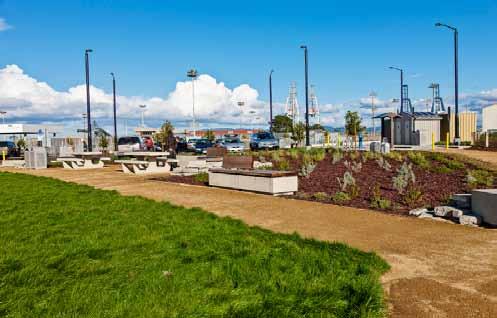
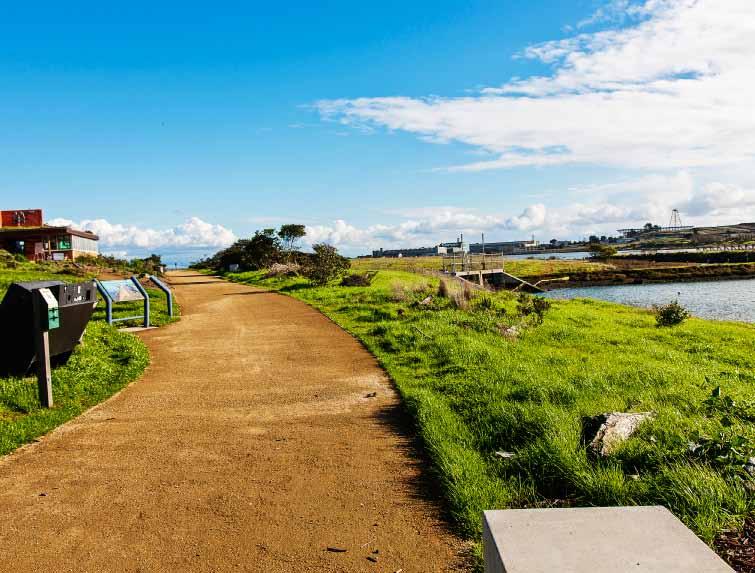
PARK from page S13
space was unveiled late last year in a ceremony that included Mayor Ed Lee.
Improvements to the park – which formally opened as a green space in 1999 – include the addition of an offleash dog run, a parking lot with 25 spots, two green “composting” restrooms, bicycle racks, kiosks with park, wildlife, restoration and other information, and barbecue pits and bench areas.
The off-leash space has been positively received, according to Port of San Francisco environmental affairs manager Carol Bach, and is fulflling its purpose to provide an area where dogs can run around without disturbing wildlife, which had been frequently occurring with unauthorized off-leash behavior on the park’s main path. It appears that many dog owners who use the park are “relieved that there is a place for off-leash dogs,” Bach said.
Potrero Hill business owner and Bernal Heights resident Dave Dos Santos regularly visits the park with his seven-year-old dog, “Toe.” Dos Santos comes almost daily after his work at Potrero Coin Laundry on 18th Street, and loves what the Port has done with the park. On one evening at dusk, Dos Santos said his favorite part of the little-known open space is the views framed by industrial buildings at Pier 96, the City lights from Hunters Point, and the distant Oakland hills across the water. He also called construction of the parking lot a major improvement
compared to the less than desirable parking options that were previously available.
Improvements were also made to the path that leads to the tip of the park, which had consisted of decomposed granite and was eroding. Midway through the renovation process – which commenced in 2010 – the Port decided to repave the path with a different granite material – called “granitecrete” – which is more permeable and lasts longer. The EcoCenter building in the center of the park wasn’t modifed. However, according to Bach the educational programming which had been operated by Bayview-based Literacy for Environmental Justice is no longer being offered. The Port is looking for a new operator to provide environmental education and youth programming at the center.
More changes will come this year, with a public art piece slated to be added to the park sometime in late-2013. Blue Greenway signage will be installed by the fall near the park to provide continuity along the entire Greenway trail system, the San Francisco portion of the multi-county Bay Trail.
Although not named after the native herons, Bach noted that a Great Blue Heron hangs-out at the furthest pond away from Heron’s Head entrance. Other birds in the marsh include California Clapper Rail, American Avocet and dozens of others fying south during the winter months. A diversity of bird species can be seen at the park in November, December and January, the peak of the migratory season.

january 2013 | southside/potrero view DS15
These pathways wind next to the bay at heron’s head Park, an open space named for the shape it resembles when viewed from above. The $2.5 million makeover ws funded by a 2008 municipal park bond. PhotoS bY DoN NoltE
City PLans from page d13
current digesters were worn out 20 years ago, they get patched but they often leak gas. They smell.”
Replacing the existing digesters with new technology should mitigate the odor issue. Mark Klaiman, co-owner of Pet Camp, which is located across the street from the plant, admitted that there was an odor, but thinks the plant makes for a good neighbor. Klaiman was also a SDT member, and voted to recommend the digesters stay where they are. “The plant has been a good neighbor. When they have a problem, they are generally responsive,” said Klaiman.
A nearby lot at Selby and Evans is one of fve sites being considered by SFPUC to house the Eastside Recycled Water Project. Most of the City’s drinking water comes from the Toulumne River, via the Hetch-Hetchy reservoir. Under the recycling initiative water would be taken from the Southeast plant and processed once more to make it safe for non-potable purposes. Currently, all of the City’s treated water is discharged into the ocean or the bay. Recycled water could be used for irrigation, toilets, and commercial or industrial uses, such as cooling systems, potentially replacing more than two million gallons a day of Hetch-Hetchy water.
For the last few months, the SFPUC has been trolling neighborhood events, iPads in hand, to teach people about the benefts of recycled water, and ask them their preferred site for a recycling water treatment plant. Of the fve sites
— all of which are located in Southside San Francisco, and include Seawall Lot 337 across from AT&T park, Pier 70, the Selby and Evans lot, Pier 90-94, and Griffith Pump Station in Hunters Point Shipyard — Alison Kastama, SFPUC’s regional communications manager, said so far there’s been no clear winner or loser among those polled.
Residents were also asked what they thought were the positives and negatives of such a system. “One thing they did mention in the survey was the positive aspect of creating jobs and jobs for the neighborhood” said Kastama. “This will be mentioned in our review.”
The recycling plant will be less than an acre in size, and is also a long way off, with construction slated to start in 2018. In addition to the plant, new pipelines – colored purple, to denote their use to convey recycled water – must be installed. However, those pipelines won’t extend throughout the City, with recycled water instead dedicated to a limited number of high use clients. For instance, most Mission Bay developments feature dual plumbing as a result of a 1991 City ordinance that requires large new construction and remodel projects to be plumbed for recycled water.
Both projects mean a lot of construction activity in the district in the coming decade. But some Southside residents won’t believe that SFPUC is actually doing the work until they see it. “I will be excited when I see the frst bulldozer out there,” said Hamman.
cisco Department of Building Inspection (DBI) issued a Notice of Violation to Vasquez “for an alleged unpermitted change of occupancy at the Property from a residential property to a commercial auto repair shop.” DBI issued a second violation notice later that year, but it wasn’t until 2007 that the department scheduled a Notice of a Director’s Hearing, at which Vasquez was supposed to appear to explain why he didn’t address the alleged violations. Vazquez didn’t attend that hearing, prompting DBI to issue an Order of Abatement No. 102164-A, declaring the property a public nuisance and ordering the “defendants to complete all work within 30 days.” It is unclear whether DBI conducted any follow-up inspections.
rePair shoP from page s13 number of incidents involving the San Francisco Police, Fire and Planning departments. In one alleged incident, a Department of Parking and Traffic “employee requested police presence while he cited 15 to 16 vehicles illegally parked on the sidewalk in front of the Property.” In another alleged incident, Vasquez was a victim of battery. In three alleged incidents involving the police, Vasquez was accused of not returning a vehicle under repair to the car’s owner. One of these incidents was resolved amicably, according to the suit. In the sixth of seven alleged police incidents, SFPD “conducted an undercover detail targeting Defendants’ unpermitted vehicle repair garage.” According to the suit, Vasquez told an undercover officer that he’d perform transmission work on a vehicle on the property at 1266 – 1278 Thomas Avenue.
The City Attorney’s suit details a

ENVISION SCHOOL


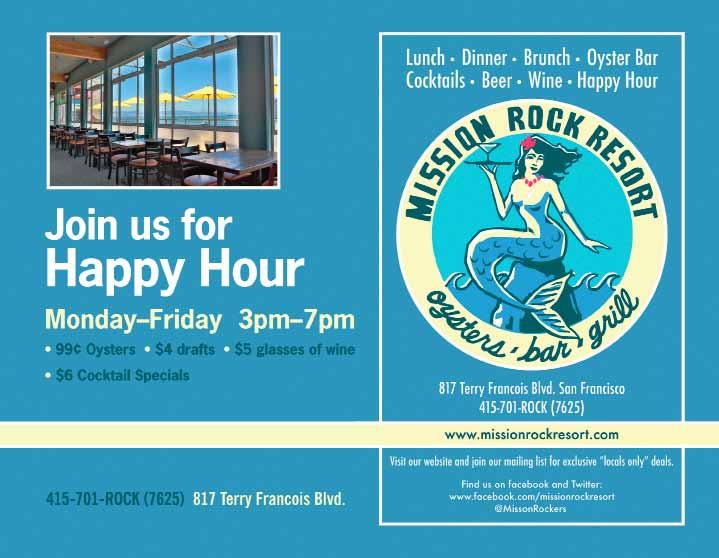
D southside/potrero view | j anuary 2013 S16
The Dance of Local Politics
By S T EVEN J. M O SS
In 1973, Eric Redman published The Dance of Legislation , relying on his two years as a member of U.S. Senator Warren Magnuson’s staff to trace the drafting and passage of a single piece of legislation. The book, which became a classic description of the legislative process, provides a vivid picture of the bureaucratic infghting, political prerogatives, and Congressional courtesies necessary to make something happen on Capitol Hill. Throughout 2013, View publisher, San Francisco State University adjunct lecturer, and former Board of Supervisor candidate Steven Moss will publish installments of The Dance of Local Politics , highlighting the often humorous and sometimes teeth grinding process that makes up San Francisco politics. If you’d like to support this project, either fnancially or by helping to secure a publisher for it, contact: editor@potreroview.net.
EPIPHANY
The idea exploded in my head like a burst of lightening: I’ll run for the San Francisco Board of Supervisors, in District 10! For months I’d been struggling with what to do with my life, now that I was approaching 50. There’d be an open seat in the upcoming district elections for the board – the governing body for the combined city and county – with the incumbent, Sophie Maxwell, termed out.
I knew the district – where I’d raised my daughter, started a nonproft, and published a neighborhood newspaper –and was known in it.
“Dad?” my daughter, Sara, asked from the backseat of the car. “Wasn’t that our exit?”
I snapped out of my revere. “Uh, yeah,” I replied. “Oops.”
“Dad!” Sara barked. “We’re going to be late for our feld trip.”
“Yeah,” her cousins, Adam and Olivia chorused. “The bus is going to leave without us!”
I was driving the three of them to summer camp in Foster City, 22 miles south of San Francisco and I’d missed the last exit before the San Mateo Bridge. The program started at 9 a.m. It was 8:50.

“No worries,” I said, “We’ll get there in time.”
As we were funneled onto the seven mile long bridge, I tuned out the loud grumbles from the backseat, settling back into my fevered fantasy. San Francisco’s supervisors were elected from one of eleven geographically-defned areas. We’d moved out of District 10 – where my nonproft and newspaper were located, and where we’d lived for most of the previous decade – to Liberty Street, near Dolores Park, less than a year ago. To run we’d need to move back. My wife, Debbie, wouldn’t be so keen on that; she’d wanted to live on Liberty Street since she frst moved to San Francisco in the late-1980s. Still, she’d probably go along…if I presented the idea in the right way.
I got to the end of the bridge, exited, and circled back through the toll booth. My Fastrak beeped the $5 debit.
“We’re going to be late, Dad!” Sara shouted.
“We’re okay, we’re okay,” I insisted.
I tightened my grip on the steering wheel, and foored it. Speeding along, I dropped back into my day dream. I’d probably be one of the most qualifed
candidates, having worked in the U.S. Congress and for the White House budget office. I’d been a Fulbright Scholar in India. And I’d taught public policy at local universities for the past ten years. I’d never run for anything before – not even student council – but how hard could it be?
We arrived at camp at 9:15. Sara, Olivia, and Adam scrambled out of the car. If they were teenagers, instead of pre-adolescents, they’d have been cursing me. As we rushed through the entry gates I saw their bus idling around the corner. We’d made it before the feld trip departed.
If I was paying attention I might have left the idea of politics in its dream stage. A missed exit, forcing us over a bridge-too-far, triggering an angry mob behind me – even if they were merely three kids late for camp – didn’t seem like a propitious way to launch a campaign. But if it was a prescient metaphor, I chose to ignore it. Within two months I started campaigning for the San Francisco Board of Supervisors in District 10; several months later we moved to a rental house around the corner from where we used to live. I’d become a politician.

17 THE POTRERO VIEW January 2013

18 THE POTRERO VIEW January 2013
boosters hoLiday Party
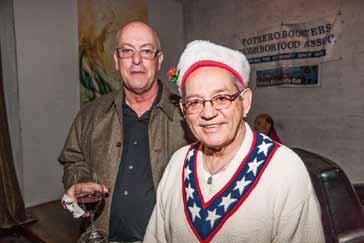
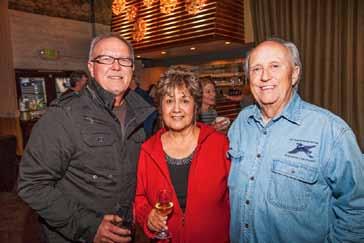
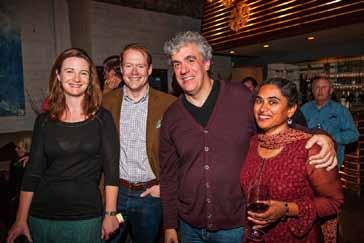

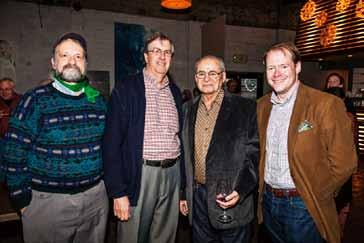










19 THE POTRERO VIEW January 2013
state senator Mark Leno, top right photograph, was among the guests at the Potrero boosters neighborhood association’s December party.
PhotoS bY DoN NoltE

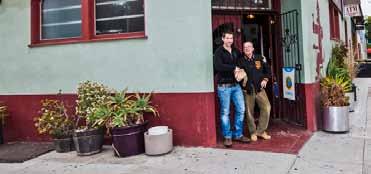
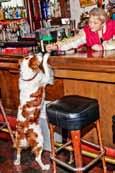






Dogpatch Saloon Changes Hands
By KEITH BURBANK
Dogpatch Saloon has new owners, who plan to make changes to the iconic bar while maintaining its essential spirit. “We want the Dogpatch Saloon to be a neighborhood place,” said one of the four new proprietors, Marc Goldfne, who has roughly 14 years of experience as a bartender. Goldfne and his partners – Chris Barry, Sky Wegman, and Derek Jostad – also own fve-year old 83 PROOF, at 83 First Street. Barry and Wegman are experienced bartenders; Jostad is adept at accounting.
a “laid back atmosphere with comfy booths,” a pool table and jukebox, reminding some of “what a corner bar should be…jazz fans…” insist that thirsty customers “must visit on Sunday.” Each Sunday the bar hosts a jazz jam, which will continue under the new ownership.
“My dream was to have a bar with jazz.”
MIKE APICELLI
At Dogpatch Saloon the four men plan to “beef up the beer” – adding draft beer – and “booze selection” – with new cocktails on the menu, Goldfne said. All of the beer taps and most of the bar equipment will be replaced. The saloon’s previous owner, Mike Apicelli, will take some things with him, prompting changes to the décor. “We want it to be a welcoming place,” said Goldfne. “The neighborhood has some history,” indicating that new furnishings may be added that pays tribute to Union Iron Works, Bethlehem Steel and the Pier 70 shipyard. “We’re still fnalizing some of the plans,” he said.
Apicelli owned the Saloon, which was previously named “Bouncers,” for nearly 14 years. He gave the bar its current appellation, and claims that he was the frst person in the neighborhood to name something “Dogpatch.” According to Zagat 2013 ratings, Dogpatch Saloon has “friendly folks” and
Apicelli started the tradition nine years ago, after another place that hosted the event closed. “Why don’t we start something,” Apicelli asked his friend, neighbor, and drummer Vince Lateano, and jazz on Sundays was born. Every week Lateano plays drums, with Andrew Speight on saxophone. “My dream was to have a bar with jazz,” Apicelli said. “I’m a music buff, but jazz is what’s it’s all about for me.” The retiring owner listened to WBAL in Baltimore when he lived in Groton, Connecticut, his hometown. He heard Billy Holiday and jazz, and “that’s how [my love for jazz] started.”
According to Goldfine, the bar will continue operating in its current form until mid-January. It’ll then close for renovations, reopening by the end of March. “That’s ideal,” Goldfne said of the reconstruction schedule. “It’s an old building. So, you never know what you will fnd.” The new owners may make some changes to the saloon’s staff, after they assess what each current employee wants to do, and determine if that meshes with their plans. “They’re some good people there,” Goldfne said, but customers will probably see some new faces.


20 THE POTRERO VIEW January 2013
a toast to continuing an old tradition in a new way, at Dogpatch saloon. Photo bY DoN NoltE
January 2 through 13
Theater: Something Cloudy, Something Clear Tennessee Williams called it “one of the most personal plays I’ve ever written.”

Set in Provincetown, Cape Cod, in 1940, the play records Williams’ experiences during that “pivotal summer when I took a crash course in growing up.” On the brink of becoming a successful playwright, Williams was also to “come thoroughly out of the closet” and meet Kip, his frst great love. Something Cloudy, Something Clear re-imagines that long ago time, recollected through the flter of all the playwright’s successes and failures. Tickets: $10-15. Eureka Theater, 215 Jackson Street. Information: therhino. org, 552.4100.
Begins January 9 (12 classes)
Garden: Fundamentals of Growing Edibles
Growing food is a powerful act, offering personal joy, skill development, and community building benefts to the gardener. In this 12-part class you will develop these skills and start building a reservoir of information. The classes and garden days are scheduled to mirror the actual planting season: you will learn about garden planning and soil vitality at the beginning, then how to pick varieties and plant them, and last how to harvest and set your garden up for the next round of production. Sliding scale: $350-$425. Payment plans available. Second Wednesdays and Saturdays, January-June: 12 sessions total. Location: 18 Reasons, 3674 18th Street; and Garden for the Environment: 7th Avenue and Lawton Street. Information: 18reasons.org or 568.2710.
Comedy: Kung Pao Kosher Comedy Returns to El Rio
Now in its 4th year, this popular and diverse monthly (every 2nd Monday of the month) comedy show features the best of Bay Area comedians and beyond. The show features Dhaya Lakshminarayanan, Lynn Ruth Miller, Kenny Yun, Bobby Golden, and Lisa Geduldig – a great line-up of talent, including storyteller and stand-up comic, Dhaya Laksminarayanan, the 71 year old,
Ruth Miller who started in Edinburgh in 2005, local writer and actor, Kenny Yun; Californian Persias who began at 17 years old, Bobby Golden; and Lisa Geduldig, local comic and comedy producer who began her career 23 years ago.
Tickets: $7-20. 8 p.m. El Rio, 3158 Mission Street.
Information: Lisa Geduldig, 522.3737.
Begins January 16 (10 classes)
youth Class: City Studio, Sound and Light as Music
The course will cover the fne line between sound art and music in the sphere of performance and video with new developments in multimedia software. Students will use similar editing and collage strategies with video to create installation, performance, and screening based By the end of the course, students will produce a compilation of audio/ visual material in the form of performance, installation, packaged products, or web-based projects. Youth ages: 12 to 19. Free. Wednesdays from 4:30 to 6:30 p.m. SOMArts Cultural Center, 934 Brannan Street. Information: 863,1414 ext. 112; jess@somarts.org

Music: Symphony Parnassus Concert, Travelogue
Musical director Stephen Paulson returns from the SF Symphony’s triumphant tour through Asia to conduct a musical journey with Symphony Parnassus from Italy to Africa in Rossini’s Overture from “Italian Girl in Algiers”, then through Germany and Austria in Beethoven’s Piano Concerto No. 2 in B-fat, with sparkling 16-year old soloist Hilda Huang, and fnishing in grand Russia with Tchaikovsky’s masterful 5th Symphony. SF Conservatory of Music Concert Hall, 50 Oak Street. 3 p.m. Tickets: $15-$22. Information: 370.5639, symphonyparnassus.org

CALL FOR ART! Exhibition: From Steels to Wheels
The Potrero branch library and Farley’s Coffee in collaboration with a guest curator invite artists to participate in From steel to Wheels, an exhibition dedicated to the past, present and future of the current Cor-o-van structures (1200-1210 17th street and 965 16th street at Mississippi). Proposals will be welcomed through January 2013. e xhibitions will open saturday, February 23rd at the Potrero Library and Friday, March 1st at Farley’s. information and submission guidelines: corovan.blogspot.com or e-mail hillianpotrero@gmail.com

January 23 – February 5
Film: African Film Festival 2013
The annual African Film Festival provides a striking

opportunity to learn about Africa and the African diaspora through recent films. The concerns of African filmmakers are often aesthetic and political — the desire to depict the realities of their everyday lives and to interpret their history from their own perspective. A number of the featured documentaries look to the past to examine forces that continue to infuence the present. Our Beloved Sudan traces the complex history leading to the partition of Sudan; The Unbroken Spirit focuses on the courageous fght for a multiparty democracy in Kenya; and the arc of Black Africa, White Marble moves from colonial-era to present-day Republic of Congo. All three take the vantage point of one individual in order to bring to life a larger history. See website for times. Tickets: $9.50 - $13.50. Pacifc Film Archive Theater, Pacifc Film Archive Theater, 2575 Bancroft Way, Berkeley. Information: 510.642.1124 and bampfa.berkeley.edu. For tickets call: 510.642.5249.
26+27 Children: Bay Area International Children’s Film Festival
The ffth annual Bay Area International Children’s Film Festival a Playdate for the Imagination, will screen dozens wonderful fun shorts and flms from,

1972 Tchou Tchou by Canadian flmmaker, Co Hoedeman, where two children encounter an angry dragon, all represented by colorful building blocks; to the 2010, German Mobile, where an outcast cow takes its destiny in its own hoof and makes some waves. A Cat in Paris from France. Light of the River by Tetsuo Hirakawa. Mornings for ages: 6 and up, afternoons for ages 8 and up. 10 a.m. to 4:30 p.m. $15. Art Deco Theater, 2700 Saratoga Street, Alameda. Information: 510.708.2608, baicff.com
Dinner Conversation: Fair Share, Community Supported Fisheries

Fair Share founders Jalal Elhayek and Jessica Lattif for a Dungeness Crab dinner and conversations about sustainable fshing. Launched in September, Fair Share Community Supported Fisheries offers dockside to doorstep delivery of local & sustainable seafood. By applying the community supported agriculture model to the fshing industry, they have joined a movement that is re-imagining the seafood supply chain in which sustainability and proft are not mutually exclusive. Fair Share supports local fshing communities by valuing their roles as stewards of the ocean, and by connecting them with appreciative, conscientious consumers. $35. 7 to 9 p.m. 18 Reasons, 3674 18th Street. Information: 568.2710 or 18reasons.org

21 THE POTRERO VIEW January 2013
20 14 C O
mu
L EN dar
30
m
N I t y Ca
JANUARY 2013
Dhaya Lakshminarayanan
a Cat in Paris, Light of the river
Tennessee Williams
Development Plans for Seawall Lot 337 Continues to Evolve
B y GEORGE NELSON
Plans to revamp Seawall Lot 337 – also known as “Parking Lot A” –into what the developer is calling a ‘dynamic mixed-use community’ have been gathering momentum in recent months. The Port of San Francisco is overseeing the project, which is a joint venture between the San Francisco Giants and The Cordish Companies, a Baltimore-based real estate frm, to develop the 27-acre site – including Pier 48 – now coined “Mission Rock.”
The development as currently envisioned would consist of waterfront housing for up to 2,000 new residents, eight acres of open space and 125,000 square feet of retail space. Construction would start in 2015 and unfold over the next six years.
More than 70 San Franciscans attended a community design workshop late last year to hear Port, City and Mission Rock development representatives discuss proposed project options and ideas. “Potrero Hill has been direct benefciaries of this. People may not
always like what the Port does, but I don’t think they can argue with the process that the Port does to solicit as much community feedback as possible,” said Jon Knorpp of Mission Rock Development.
Throughout the meeting concerns were raised over the development’s height, with some attendees worried that the proposed towers would block their view of the East Bay. The towers’ exact location hasn’t yet been decided, but Phil Williamson, Port development manager, said they’d be situated “to best activate the eight acres of planned open space.” As for the size of the two potential structures, “We haven’t come to conclusion on the heights since we are still evolving the design, but we are exploring the inclusion of one or two buildings over 300 feet in addition to those at lower heights, particularly along the waterfront,” Williamson said.
The developers also reiterated that while the area will have its own unique identity, it will be infuenced by the characteristics of other San Francisco







neighborhoods. “Street development in an area such as Hayes Valley is much more intimate than what you would normally see on a new development. The staccato rhythm of the close, 13-foot wide street fronts is what we have compared ourselves to. This is what people fnd most appealing,” said Knorpp.
Parking has been a contentious issue with past Mission Bay developments, and many meeting attendees expressed concerns that Mission Rock will add to existing congestion problems. “I hope they get the parking right this time,” said 54-year-old Mission Bay resident Peter Leibowitz. “This type of huge development always seems to screw up the parking, and it is the people who live here that have to deal with it. High meter rates, overcrowding and a lack of response from City officials are what’s wrong.” According to a Mission Rock handout, the site will contain a “responsible amount of shared parking to support ballpark and neighborhood uses.”
“We need to address the transit
infrastructure. Everybody understands that if you’re going to push the transit frst policy then you have to have the transit to back it up,” said Fran Weld, Mission Rock development director.
The current proposal provides the developer the ability to program the retail uses throughout the project site spanning the many shops, restaurants, cafes and galleries set to fll the 125,000 square feet of available space. Williamson said, “This should allow for the thoughtful planning of retail that meets the needs of the neighborhood and contributes a to a vibrant community.” The baseball team is striving to create a “model community, incorporating green technologies and sustainable practices to reduce energy consumption, vehicle emissions and the community’s overall carbon footprint,” according to a report by Perkins & Will, which – headed by Peter Busby, an architect known for sustainable construction practices – is responsible for master planning the project.







22 THE POTRERO VIEW January 2013

College of the Arts Wants a Bigger Canvas

Bayview Police Station Captain’s Community Meeting is held on the frst Tuesday of each month at the Bayview Station, 201 Williams Avenue. Next meeting: January 1st, 6 p.m.
Dogpatch Neighborhood Association usually meets the second Tuesday of each odd-numbered month. Next meeting: January 8th. Voting membership is open to anyone living in or owning property or a business in Dogpatch. For more information or to join/ pay online: mydogpatch.org
McKinley Square Community Group is a communication and discussion group regarding events and activities, clean up days, improvement and beautifcation, and other concerns, such as crime in the neighborhood. MSCA board meets approximately quarterly on the second Wednesday of the month. Look to the online discussion group for postings of upcoming meetings. http://groups.yahoo.com/group/McKinleySquareCommunity. Locations vary between the Potrero Hill Neighborhood House and Downtown High School. For updates, including sustainable gardening and park workdays, and our grant progress, check out the MSCA blog at: mckinleysquareblog.blogspot.com.
Potrero Boosters Neighborhood Association meets the last Tuesday of each month at 7 p.m. (social time begins at 6:45 p.m.) in the wheelchair-accessible Potrero Hill Neighborhood House, 953 De Haro Street. For more information: www.potreroboosters. org or email president@potreroboosters.org.
Potrero Dogpatch Merchant’s Association meets the second Tuesday of each month at 10 a.m. at Goat Hill Pizza, corner of Connecticut and 18th streets. Visit www.potrerohill. biz or call 341.8949. Next meeting: December 11th, 10 a.m.
Potrero Hill Democratic Club meets the frst Tuesday of each month at 7 p.m. at the Potrero Hill Neighborhood House, 953 De Haro Street. For more information: 648.6740, www.PHDemClub.org. Next meeting: December 4th, 7 p.m.
Potrero Hill Garden Club usually meets the last Sunday of the month at 11 a.m. for a potluck lunch in a local home or garden. Discussions are held on organic, edible, or ornamental gardening appropriate for Potrero Hill’s microclimate. Call 648.1926 for details.
The California College of the Arts (CCA) has proposed to alter the zoning on a property it purchased in 2011 that’s adjacent to its Eighth Street campus. The plot, which used to house a bus depot, was acquired as part of the college’s expansion plans, which include creating more instructional and exhibition space, as well as student housing. While CCA tries to secure approval from the San Francisco Planning Department and the Board of Supervisors for the zoning change – which requires a modifcation to the Eastern Neighborhoods Plan – it’s cleaning up the environmentally contaminated land it hopes to build on.
in support of the proposed legislation. The letter noted that “our organization and our neighborhood did not work for many years on a neighborhood-wide Area Plan to see it tossed aside in a wave of spot-zonings a couple of years later.” However, “we do support the expansion and future development plans of the California College of the Arts.”
CCA is currently in the process of cleaning-up the land, which previously served as a Greyhound bus maintenance yard. “Although it looks like nothing’s going on, when we bought the property we assumed all the environmental clean-up responsibilities. So for 18 months we have been doing the clean-up,” Meckel said. The ground was contaminated by leaks from underground storage tanks that held diesel fuel. Greyhound conducted some remediation, but diesel contamination remained when CCA bought the property.

Starr King Open Space SKOS The Starr King Open Space Board Meeting is on Tuesday, January 8th, 6 to 7:30 p.m. in the meeting room of the Public Potrero Branch Library. Stewardship Day is January 12th 9-12 on the open space. We will be planting our needle grass. Thank you for your donations! For more information: www.starrkingopenspace.org; email the Board of Directors at starrkingboard@gmail.com; voice mail 415-633-6756.






The property – which is bounded by Seventh, Eighth, Irwin, Channel, De Haro, and 15th streets – is currently zoned Production, Distribution and Repair-1. At the college’s request, District 10 Supervisor Malia Cohen has sponsored legislation that would re-designate the area as an Art and Design Educational Special Use District (SUD). SUDs are used for various purposes throughout San Francisco, though the “Art and Design Educational” nomenclature would be unique to CCA. According to the legislation, the new zoning defnition would “facilitate the continued operation of California College of the Arts and provide a regulatory scheme for a potential future expansion of the campus.”
CCA’s director of campus planning, David Meckel, has made several presentations outlining the college’s plans at different neighborhood groups in recent months, and will continue his outreach to the community through the spring, when the legislation is likely to go before the Planning Commission and Board of Supervisors. Meckel said he’s garnered positive responses to the SUD proposal.
Mathew Snyder, the Planning Department’s representative at the Eastern Neighborhoods Citizens Advisory Committee – an advisory body that provides input to the City in regard to implementation of the Eastern Neighborhoods Plan – called committee members’ response after Mackel’s presentation “generally positive.” After a Potrero Hill Boosters Neighborhood Association meeting – at which Meckel presented the college’s rationale for the zoning change and its potential building projects – the Boosters issued a letter
“All these years, Greyhound leaked diesel out into the ground; into the water,” said Albert Lee, senior inspector at the San Francisco Department of Public Heath, who has worked with CCA on clean-up efforts. According to Lee, in the initial stage all of the “broken and damaged tanks” were removed from the rubble, dirt and sand. “There is still residual contamination,” Lee said. “We’re doing a multi-phased extraction, using a soapy water solution to pump the diesel out.”
As part of the college’s “potential future expansion” the proposed legislation would permit “student housing, which would be limited to 750 beds on any parcel within the SUD boundaries.” The school currently has 250 beds of student housing, most of it located at its Oakland campus. According to Meckel, even if permitted the 750 beds aren’t likely to be built soon. “It’s just not realistic,” he said. More likely, student housing for the college might be built at Ninth and Mission streets, as part of a Panoramic Interests project. Panoramic purchased 104 Ninth Street in 2011, and plans to build 200 student housing units, in a project that developer Patrick Kennedy described as “green” for its prioritization of bicycle over car parking.
Instead of student housing, the Eighth Street property is more likely to be used for “instructional spaces and spaces to display student work. We’re busting at the seams for that kind of additional space,” Meckel said.


23 THE POTRERO VIEW January 2013
B y y A EL CHANOFF
 By A M BER H A w K INS
By A M BER H A w K INS
Imagine the following scenario: you’re strolling through Potrero Hill with a friend on your way to dinner. A masked man appears, points a gun at you, and demands your belongings. What’s your frst instinct? Run? Hand over your belongings? Scream?
Vermont Street resident Christopher DeNoia faced this situation one evening last fall while he was walking towards the 18th Street pedestrian bridge with a female friend, passing other foot-travelers along the way. As the pair neared the bridge, a black, two-door Mercedes-Benz CLK pulled up. A man jumped out of the car wearing a dark hoodie and Halloween mask. The man pointed a gun at DeNoia, and demanded his iPhone. DeNoia’s female friend, who was holding a beverage in a red solo cup, splashed the assailant with the drink and ran towards 18th street.
“Personally, my gut feeling was this guy was going to hurt us regardless, and action was better than inaction,” said DeNoia, who stepped forward and punched the man in the face with a right hook, hitting his mask. “The man [then] hit me in the head with the gun, and I knocked the gun out of his hands, towards the sidewalk near the walking bridge. I took a few steps to pick up the gun, and the attacker jumped back in his car and drove up San Bruno, towards 19th Street, getting away.” DeNoia picked up the weapon, which turned out to be a four millimeter BB gun that looked real, down to its fake safety.
Injuries to DeNoia’s hand required him to get four screws placed in his fnger. He was left with a mean scar and more than $11,000 of uninsured medical bills. A neighbor who preferred not to be identifed witnessed the incident, and confrmed DeNoia’s story.
Although DeNoia has studied Tae Kwon Do, some family members and friends have questioned whether he properly handled the situation, offering to buy him a new iPhone if he ever faced something similar. “Most people understand the reality that you do not know how you are going to react to a situation until you are in that situation,” DeNoia said. The documentary, The Human Behavior Experiments, highlights this well.”
The Human Behavior Experiments follows psychological studies that examined how humans act in different situations. Stanley Milgram’s well-known electroshock experiment – which tested whether people will shock another human if they’re told to by an authoritative fgure – is included in the flm.
“I probably should have just given him the phone and taken down all the details I could about the car, etc.,” said DeNoia. “Either that, or I should have just kept attacking and put him down.”






Omega Boys’ & Girls’ Club Gun Buy Back
Late last year a long line stretched past Dogpatch Saloon to the Omega Boys Club, located at 1060 Tennessee Street. Upwards of 150 people queued-up to participate in the annual Gun Buy Back event. The Club paid $200 a piece for a working frearm, spending in excess of $25,000 all in to purchase more than one hundred weapons. More people than expected came to the event; some IOUs had to be issued. The number one reason people gave for turning in their guns was the tragedy in Newtown, Connecticut.
“That was a huge motivator for people,” said Andre Aikins, the Club’s operations manager. Others came in as part of their Christmas celebrations, stating that they had guns they weren’t using, and didn’t want others to get hurt. The people turning in the guns were from every racial background and age group, Aikins said, with as many women as men. The Omega Boys Club’s mission is “to keep young people alive and free,” said Aikins.
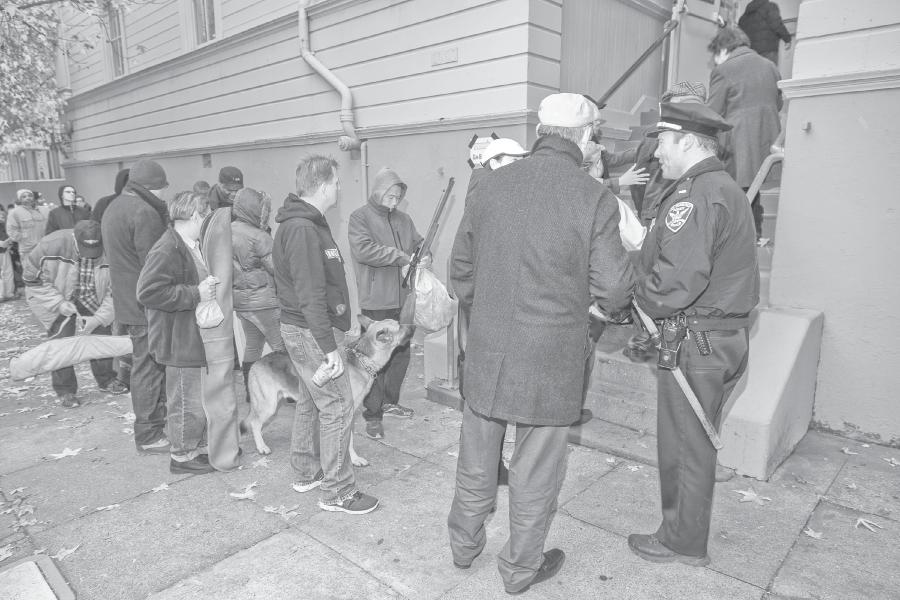
Port of San Francisco Pier 38 Rehabilitation Project
Request for Proposals (RFP)
The Port of San Francisco is seeking submittals on proposals to rehabilitate and re-tenant the Pier 38 bulkhead structure and a limited portion of the Pier 38 shed.
Contact John Doll at: john.doll@sfport.com
RFP Submittal Deadline: February 22, 2013
Grants for the Arts/ San Francisco Hotel Tax Fund Support San Francisco’s vibrant arts community by donating to the Voluntary Arts Contribution Fund (VACF). Since its inception in 1984, the VACF has provided $1.2 million in vital support to hundreds of the city’s most beloved arts organizations, serving every San Francisco neighborhood. Your gift will make possible important artistic programs and services, including safety improvements and facility upgrades.
Be part of why San Francisco is known around the world as an extraordinary arts destination – support the VACF. For more information, and to make a donation, visit www.sfgfta. org or call 415.554.6710. The VACF is a program of Grants for the Arts/San Francisco Hotel Tax Fund.
San Francisco Municipal Transportation Agency (“SFMTA”)
In accordance with requirements of the U.S. Department of Transportation (DOT) as set forth in 49 CFR Part 26 (Part 26), the SFMTA hereby notifes the public that it intends to establish a goal of eleven percent (11%) participation by Disadvantaged Business Enterprises (DBEs) on the Central Subway Project, to be attained by race-neutral measures. In Part 26, DOT sets forth regulations pertaining to how a recipient should establish
an overall goal. The regulations also include provisions regarding how a recipient should, at the direction of the DOT, express an overall goal as a percentage of funds for a project. To facilitate participation by DBEs without regard to race, ethnicity and gender, SFMTA will implement a small business enterprise participation goal on the Central Subway.
Information pertaining to this proposed DBE goal is available for inspection 8:30 A.M. to 5:00 P.M., Monday through Friday, at the SFMTA Contract Compliance Office (CCO) at One South Van Ness Avenue, 6th Floor, San Francisco, California 94103, for thirty (30) days following this publication. Comments will be accepted for forty-fve (45) days from date of publication. Comments may be sent to the SFMTA CCO at the above address. CCO can be contacted at 415-701-4443.
Department of the Environment
The SF Department of the Environment introduces RecycleWhere (www. sfenvironment.org/recyclewhere): Whether you’re working or living in San Francisco, Palo Alto, San Jose, Contra Costa, or Alameda, the online tool RecycleWhere provides the latest and most convenient recycling, reuse, and disposal options for everything from plastics to couches, and much more! RecycleWhere is collaboration among local government agencies to help each and every person reduce waste.
Time for an oil change? The 3,000 mile rule no longer applies to most vehicles. You can Check Your Number by reviewing your owner’s manual or go to www.checkyournumber.org
The City and County of San Francisco encourage public outreach. Articles are translated into several languages to provide better public access. The newspaper makes every effort to translate the articles of general interest correctly. No liability is assumed by the City and County of San Francisco or the newspapers for errors and omissions.
24 THE POTRERO VIEW January 2013
& SAFEtY reporT S PONSORED B Y M AINLINE S ECURITY C I TY & C O UNTY O F S A N F R ANCISCO JANUARY 2013 M O NTHLY
CRIME





January
The San Francisco Public Library will be closed on Tuesday, January 1st for new Year’s Day, and on Monday, January 21st in honor of Martin Luther King’s Birthday.

Programs for Adults
Golden Age of Soul Richie Unterberger presents another of his stunning collections of flm clips, this one featuring soul singers from 1960-75. Saturday, January 12, 3:30-5:30 p.m.

Book-a-Librarian: Family History Research Assistance Need help researching your family history? Schedule a one-on-one appointment with a librarian for research assistance or personalized training on how to use the library’s genealogy databases and resources. Call 415-355-2822 to request a 30-minute appointment up to two weeks in advance. Sundays, January 6, 13, 27, 1-2:30 p.m.

Dawn Hochsprung
Mary Sherlach
Vicki Soto
Lauren Rousseau
Rachel Davino
Anne Marie Murphy
Charlotte
Daniel
Olivia Josephine
Ana
Beneft for Sandy Hook Elementary
a silent auction & snowfake making party
Donate a gift certifcate or item for the silent auction, or just come and make a snowfake to decorate the halls of the school.

Avielle
Allison
Sunday, January 6, 2013 noon to 4 p.m.
Bottom of the Hill 1233 – 17th St and Missouri San Francisco
Host: Jeanné Ellenby
God has called them all home. “Let the little children come to me and do not hinder them, for to such belongs the kingdom of heaven.”



eBook and eAudiobook Help Sessions Bring your Kindle, Nook, iPad or other eReader device with you and learn how to download books and other materials from the Library website for free! For adults, 18+. Wednesdays January 9, 16, 23. 30, at 6:30 p.m.
Genealogy Research Learn how to conduct genealogy search and fnd people using U.S. Census data, vital records, directories, photos and genealogical records. Learn to access and use the Library’s Ancestry and Heritage Quest Genealogy Search. For students, amateur genealogists, and novice researchers. Sunday, January 13, 3-4:30 p.m.
Programs for Children
Lion Dancers . Come celebrate Year of the Snake with the Chinese Lion Dancers on the frst foor of the Potrero Branch Library! Saturday, January 26, 3:00 p.m.
Baby Rhyme and Play Time. For infants up to eighteen months old and their caregiver. Tuesdays, January 8, 15, 22, 29 1:15-1:45 p.m.
Family Storytime. Featuring stories, songs and rhymes. For children from birth to fve years old and their caregiver. Thursdays, January 3, 10, 17, 24, 31, 10:30-11 a.m. and 11:15-11:45 a.m.
Fun Flicks. This flm program is offered every 2nd Wednesday of the month and includes short flms based on children’s books and stories. January’s flms will be Antarctic Antics, Bear Wants More, Frederick, Snow Cat. For children ages 3 to 8. Wednesday, January 9, 6:30-7:15 p.m.
Homework Help. A Library Volunteer will be available to help students K-12 with homework. Tuesdays, January 8, 15, 22, 29, 4-6 p.m.
Library Sponsored Community Partnerships
San Francisco Seed Library at the Potrero Branch Library
In partnership with the San Francisco Seed Library, the Potrero Branch Library has seeds available for “checkout.” Located on the 1st foor beneath the staircase.
The Potrero Hill Book Club
meets at the library every third Wednesday evening. January’s selection is The Cat’s Table by Michael Ondaatje. Join the discussion on Wednesday, January 16, 7-8:30 p.m.
Creative Writing Workshop
Join writer, flmmaker, journalist Shevi Rosenfeld Loewinger for a free class to help you write your own stories, develop your characters, and fnd your own unique voice in a supportive and creative environment. Thursdays, January 17, 24, 31, 12:30-2:30 p.m. Please contact Shevi for more information: sheviros@ gmail.com or 415-602-7961. Please note: NO WORKSHOP on Jan 3 or 10.
25 THE POTRERO VIEW January 2013
B A RNES , P O TRERO B R ANCH L I BRARIAN
C o M P l i M EN tA RY AD SPACE C o U R t E SY o F THE VIEW
Get a Job
By M A URI S C H w A RTZ
The View asked Hill resident and career expert Mauri Schwartz to answer questions from job seekers. Submit your questions to editor@ potreroview.net.

Q: I have a job that is ok but I would like to make a change. Since I work full time, conducting a time-consuming job search is not possible. Should I use an executive recruiter? If so, what should I look for in choosing someone to work with me?
A: A skillful recruiter can be a huge asset to a company which is hiring and to you in your job search, but before you enlist his assistance, there are two important facts to consider:
(1) In today’s job market, for each position the company will likely receive several hundred resumes from a number of outside recruiters and from their internal recruiting staff. All else being equal, the decision maker will choose the candidate that does not come with a hefty fee, one sourced by her own recruiting staff. Depending on the situation, you may have a better chance by applying directly.
(2) Another point to note is that the recruiter works for the company which is hiring. By that, I mean that a company has hired the recruiter to source specifc talent. Therefore, the recruiter will have the company’s best interest in mind. If the recruiter is “retained” to conduct the search, he will receive at least some of his fee in advance and will be expected to present only the top 3 or maybe 5 candidates. A contingency recruiter will be paid a percentage of the hiree’s base salary but only if the company hires one of his candidates. You may consider this fee as 100% commission. The recruiter will receive nothing if none if no placement is made. Keeping this point in mind, you can appreciate how a recruiter prioritizes his time.
Nevertheless, a good recruiter will attempt to respond to your needs too because a candidate represents the necessary other side of the transaction. You should expect to be treated professionally and with candor. Sometimes what you want is not possible, and the recruiter may offer alternatives which you should consider if you trust him.
You may want to work with more than one recruiter thinking that this will increase your chances. Interview a number of recruiters and select a manageable number, probably 1 or 2, no more than 3. Consult your friends and colleagues for recommendations. Assess whether or not you and the recruiter are compatible. Will he meet with you in person? Did he listen to you and understand your preferences and concerns? Did he present his recruiting process so that you will know what to expect. Do you think he believes in you? This person must be able to present you to his client in the most positive way possible, to sell you.
Insist that your resume not be submitted to any client for any position unless you have approved it in advance. The same goes for references. There is really no reason for a recruiter to request references prior to a company in the offer or fnal decision stage. You must be in control of where your resume goes. Otherwise, you could end up in a sticky situation and you will end up the loser. You and the recruiter could end up submitting your resume for the same position, independently. Faced with this dilemma, the hiring manager will most often reject your resume in favor of the many other ones he has received.
Other characteristics to look for include:
The positions he presents to you refect your strengths and preferences. A good recruiter may play around the edges and present opportunities that do not completely match. Keep in mind that nothing is perfect, or rarely is. However, when the recruiter does this, does he acknowledge the aspect that does not match?
He is very knowledgeable about the company and the hiring manager and can answer questions you may have about the substance of the work, culture, and management style. Hopefully, he will have a good relationship with the hiring manager, such that the manager trusts the recruiter’s choices.
He will help you prepare for the interview and when scheduling, provide you with details of your agenda – how long the interview will last, whom you will be meeting, what to expect. If the recruiter has properly debriefed other candidates, he will be able to share details with you about interview style, questions a particular interviewer asks, or whether or not there will be technical test of some kind.
A good recruiter will stay in touch and keep you up to date, even when the news is not good. He will return your calls and emails as long as you do not become a pest.
Art and Music
FLUTE LESSONS IN POTRERO HILL
Start the New Year with music! Private fute lessons available for ages 3-103. Traditional and Suzuki method, all styles of music. futely.com, jenny.m.hanson@gmail. com
Community Activities
‘GYPSY’ WAGON There was a large covered wagon parked in the driveway at 1002 Carolina Street in 1979, used by a palm reader. Anyone know her name or have any info? Please contact brollecaravan@hotmail.com
Home Services
CARPENTRY & PAINTING also: plumbing, seismic/structural work, stucco, roof repairs & gutter cleaning, tree trimming. www.FarWestConstr.com Jim Kennedy, 415-276-1990 Ca. Lic. 751689
TOM’S PLUMBING Tom’s been satisfying Potrero Hill customers for over 30 years. All plumbing needs handled promptly and efficiently at a very low cost. Keep it local and call Tom Keats! 415-824-3538
Housekeeping
CLEANING PROFESSIONAL 26 years Experience. Apartments, homes or offices. Roger Miller 415-794-4411 References
Photography
FREE PORTRAITS BY PROFESSION-
ALLY TRAINED HOBBYIST I am a retired professional who now does portrait photography as my hobby/passion. I have a studio on Potrero Hill with top quality equipment where I do free portraits & prints for families or individuals. There is no catch, professional quality for free, and fun for all. Contact me at alcastino@ mac.com and I will send a link to sample photos.
Rentals
CHARMING GARDEN APARTMENT One BR, 2-night minimum. Fireplace, patio, deck, French doors. 415.641.4488.
SPACIOUS AND BEAUTIFUL Furnished guest garden apartment. Private. 1/2 blk. to restaurants. Non-smoking. 2 people. 415-861-3208.
VACATION RETREAT FOR POTRERO
HILLIANS Sonoma Wine Country home; 8 miles to St. Helena; Comfortable, cozy, ; 3 bedrooms, 2 baths, sleeps 6 (max). Fireplace with wood. Sunny decks, all year stream. 30 acres of gardens, meadow, redwood, fr, madrone, oak. Dogs OK. See: spot02.googlepages.com 415-647-3052 . 2 nites = $600 then $200/nite. 7th nite free.
Technology Services
COMPUTER PROBLEMS DRIVING YOU
BUGGY? Problems fxed! 25 years of industry experience. Personal IT consulting to small businesses or busy professionals. We can install and/or help shop for computer/network/printer or setup/ troubleshoot wireless networks. If you’re not technical, don’t worry - we are. Rob 415.244.3305 rob@sfcomputech.com.


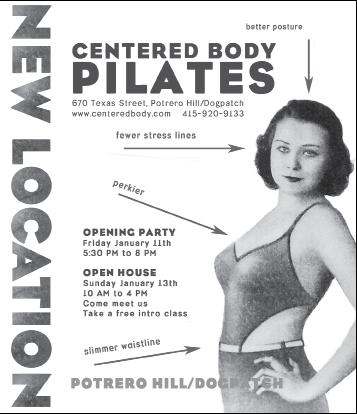
26 THE POTRERO VIEW January 2013
By M A URI S C H w A RTZ Southside AN INSERT OF THE VIEW



Pennsylvania Street Makeover

here are a couple of photos of Pennsylvania street between Mariposa and 17th after the makeover. This area was really unsightly and neglected until annie shaw and emily Gogol – the neighbors responsible for Pennsylvania Gardens, got a Community Challenge Grant, organized a community of probably two dozen helpers, and – during a few weekends – created a very pleasant, paved with decomposed granite, walkway, and planted area. There’s still more work to be done. but for anyone who knows what the CalTrains side of that street used to look like, the transformation is remarkable. PhotoS bY bill SlAKiN

27 THE POTRERO VIEW January 2013
b Y b ill S l A K i N
M o r E P H o to S P 9

28 THE POTRERO VIEW January 2013




































































































































































































 By A M BER H A w K INS
By A M BER H A w K INS


























